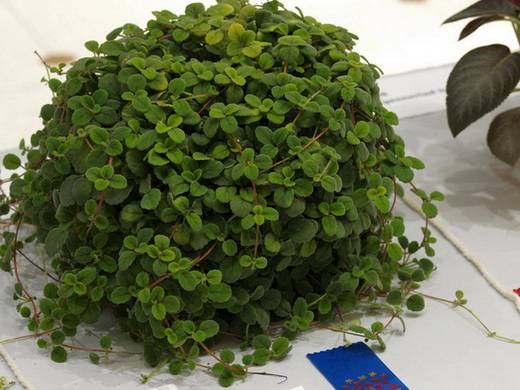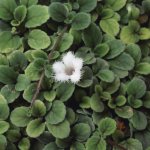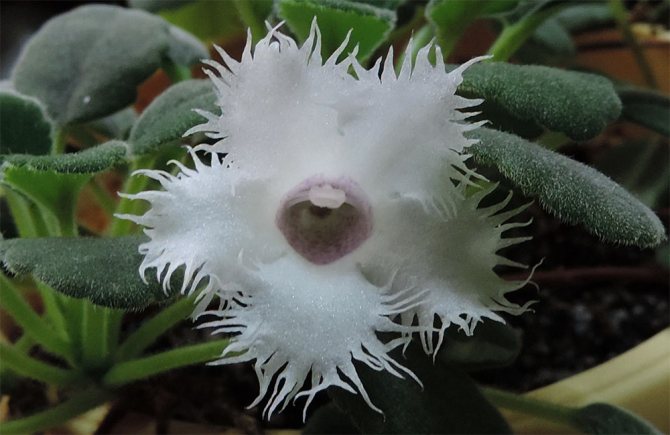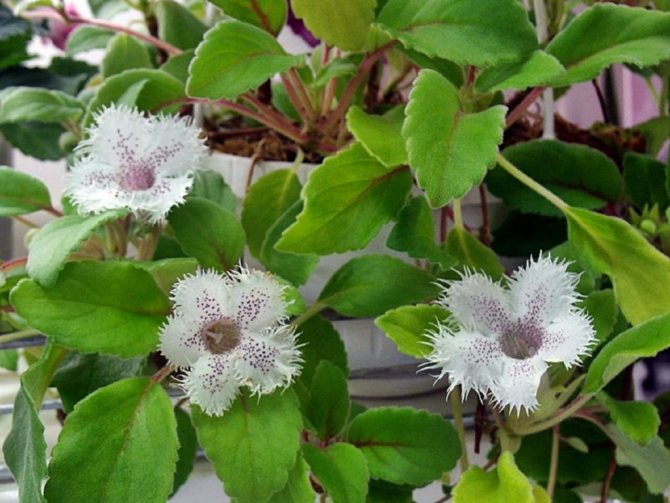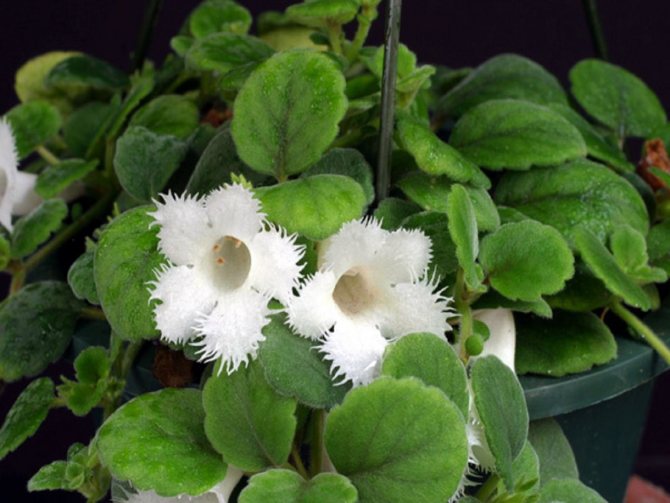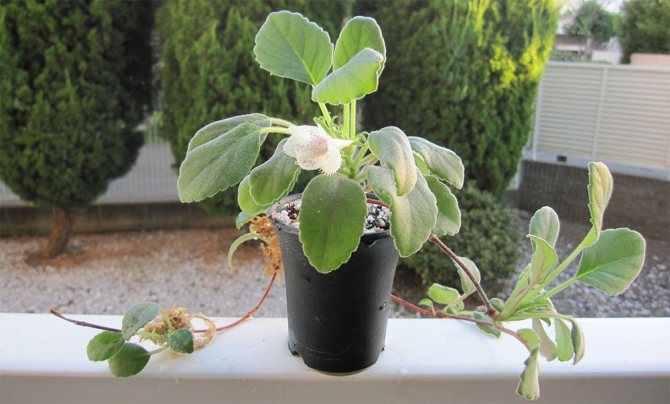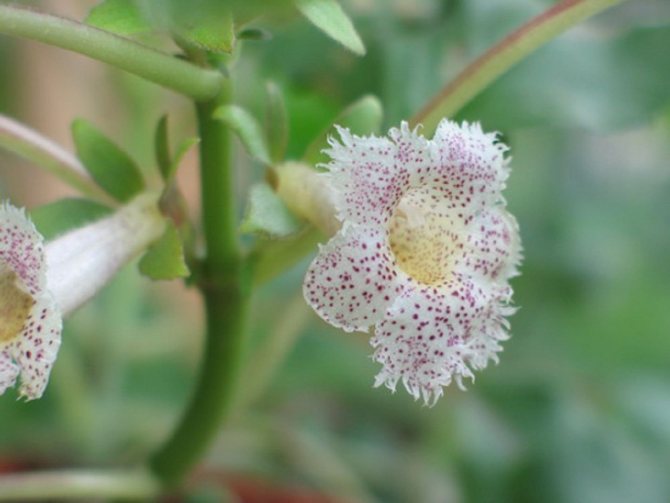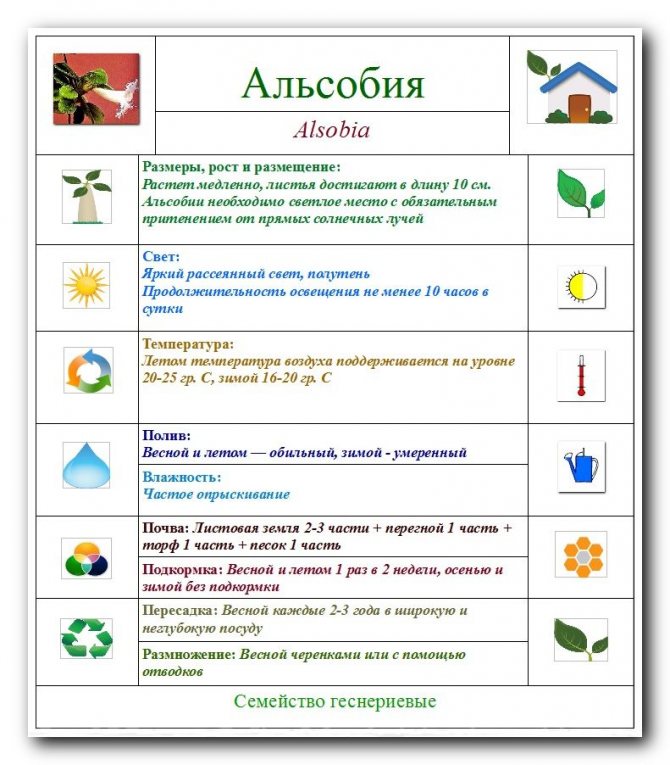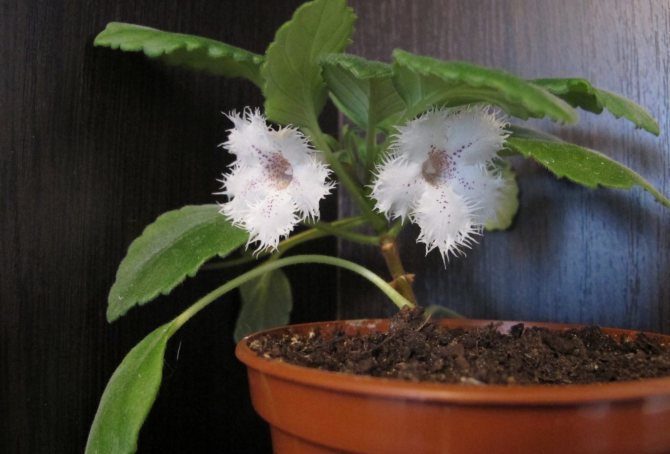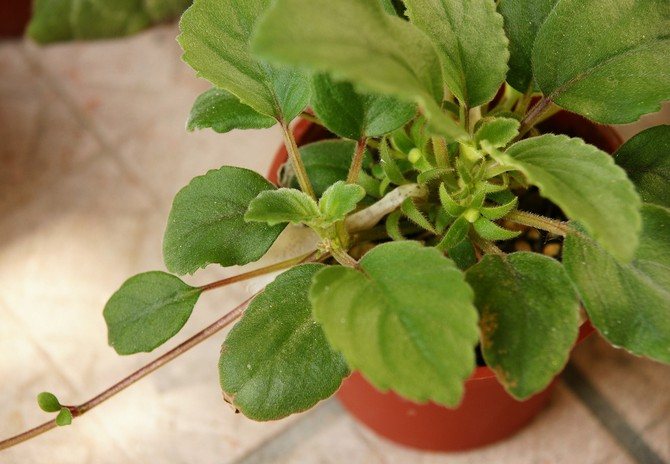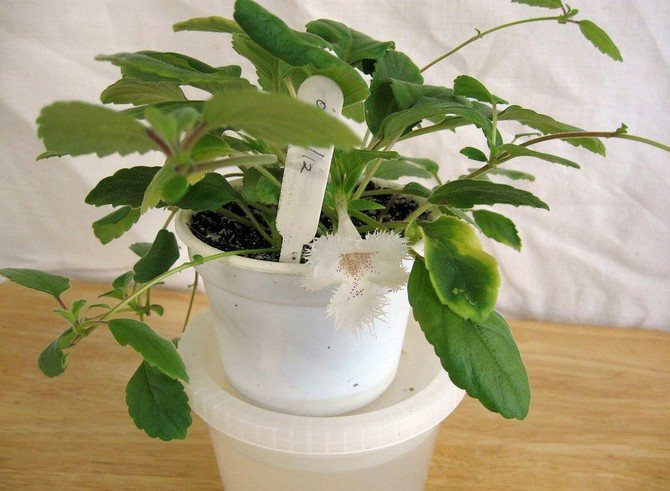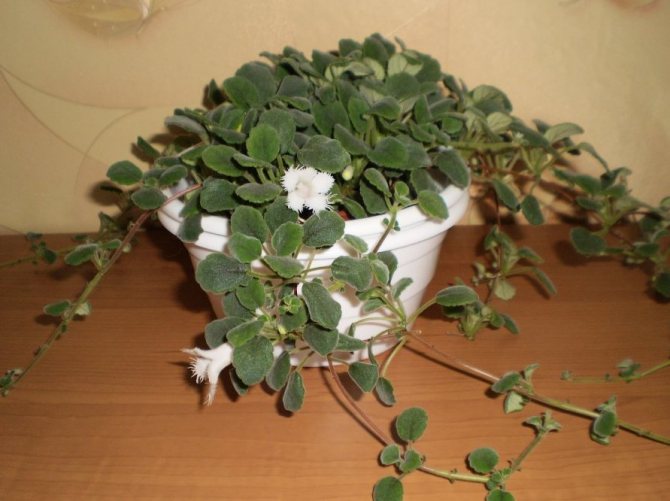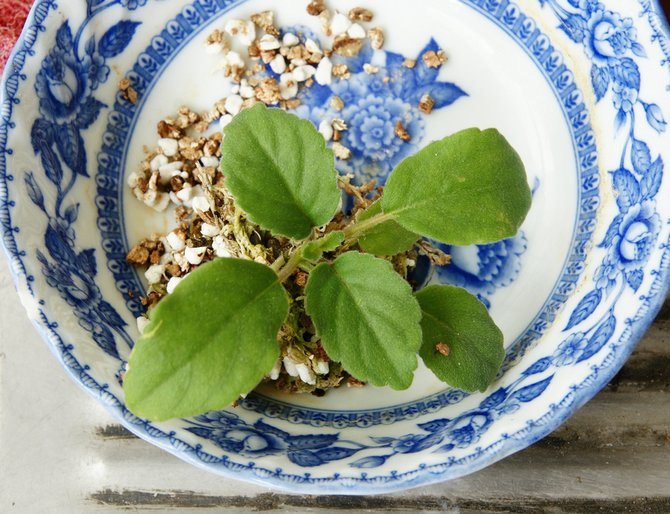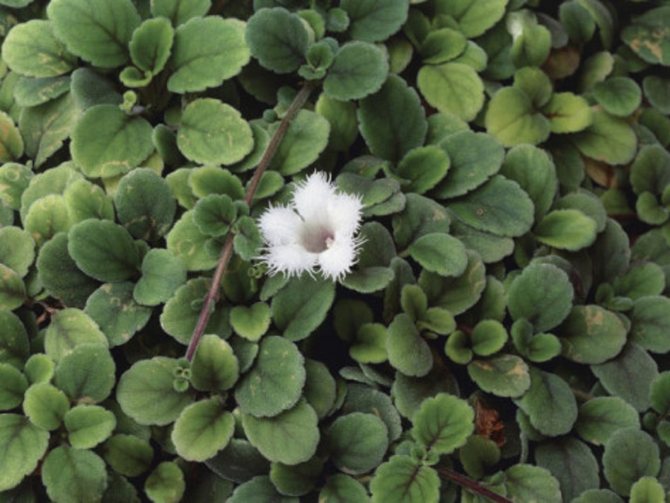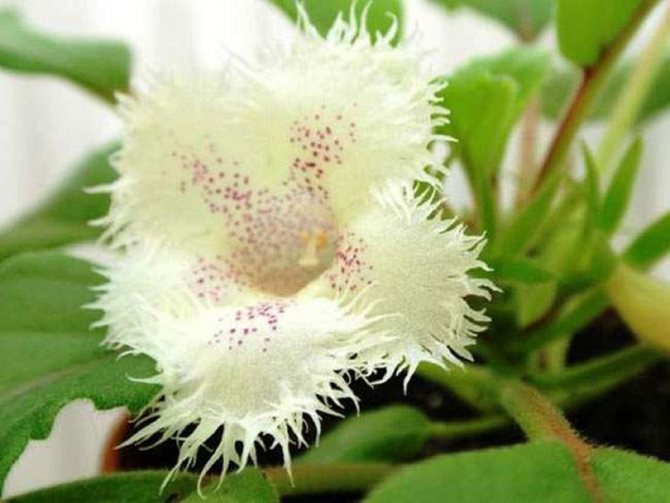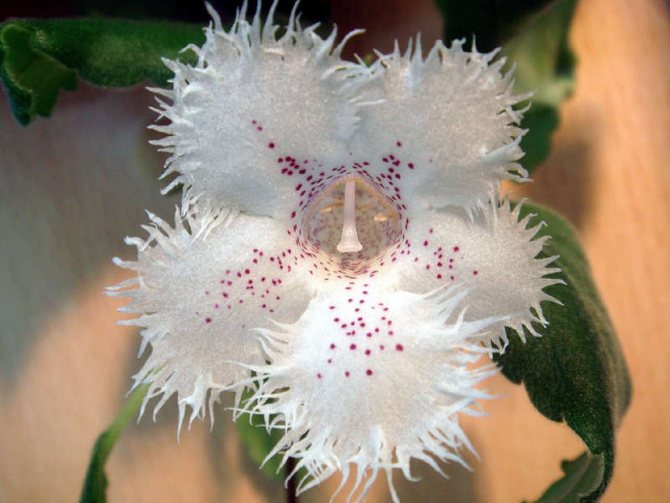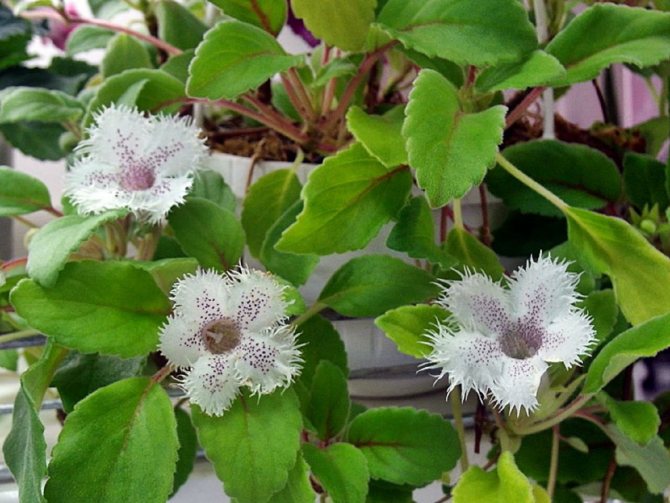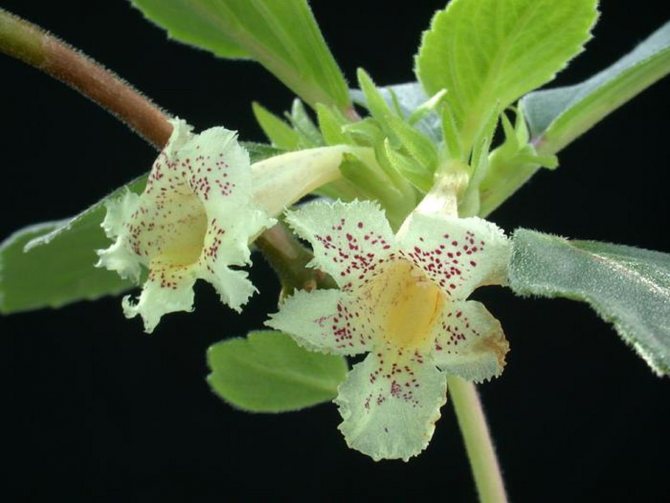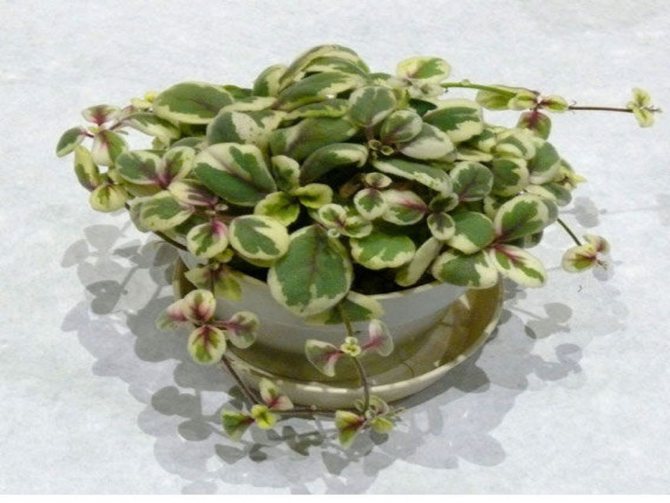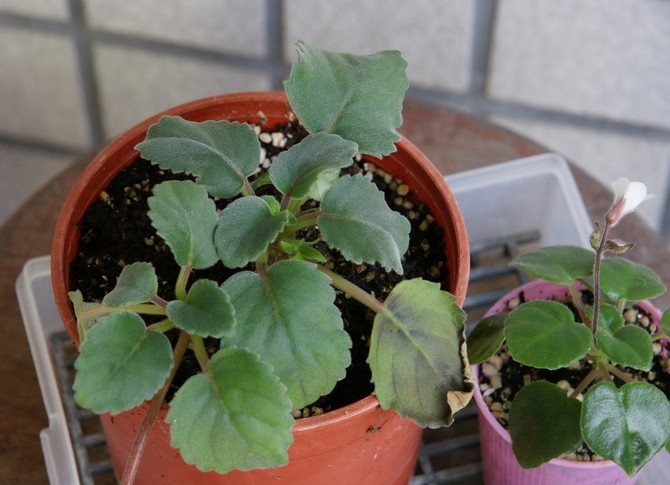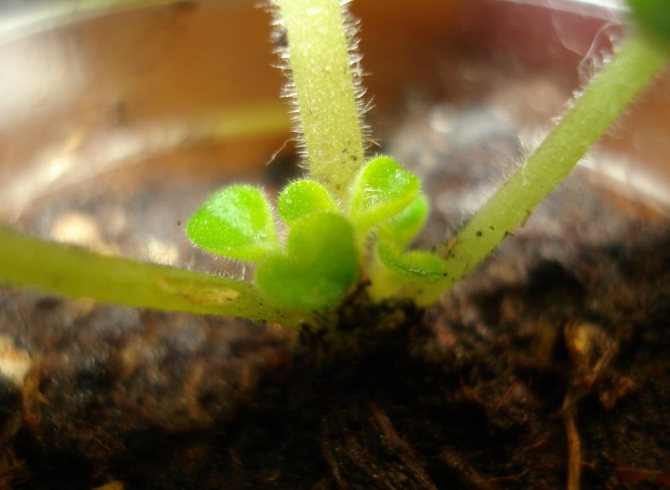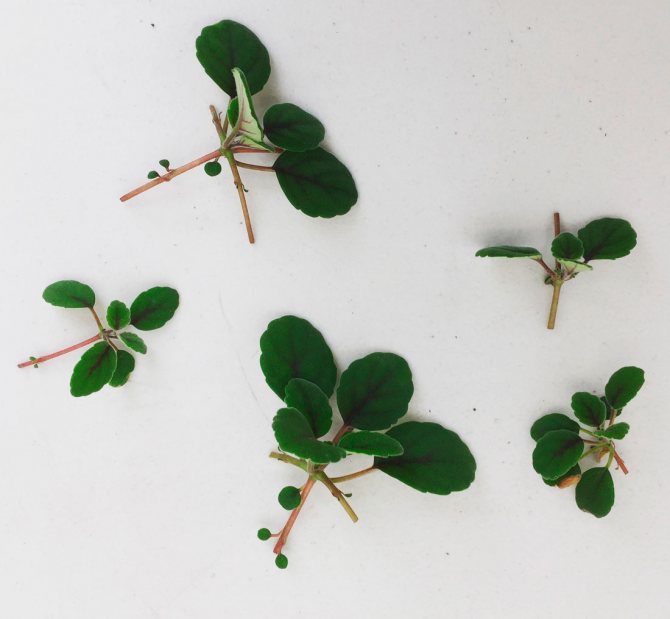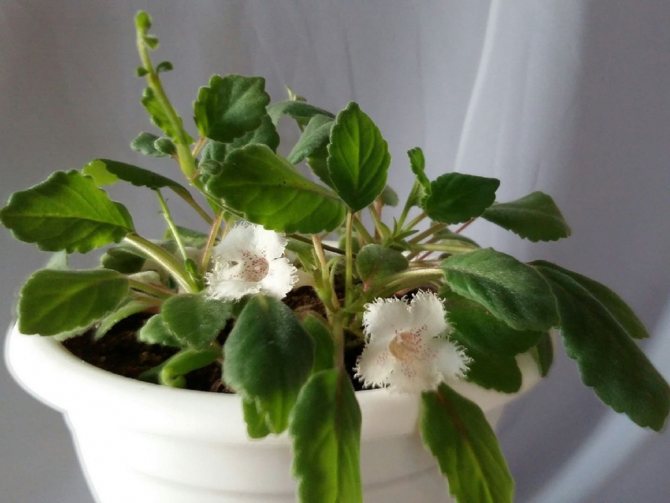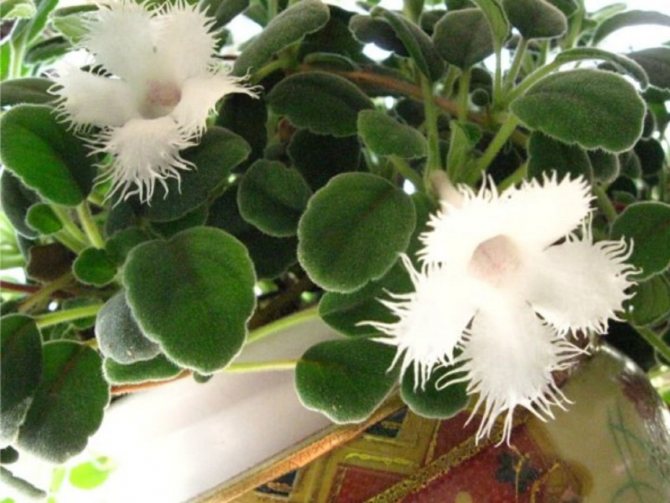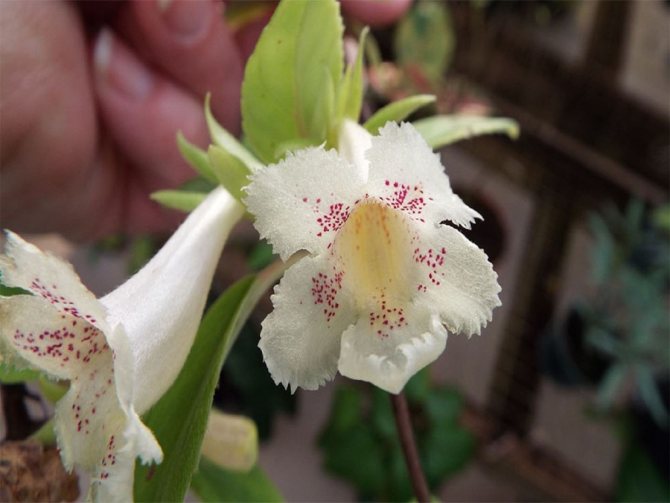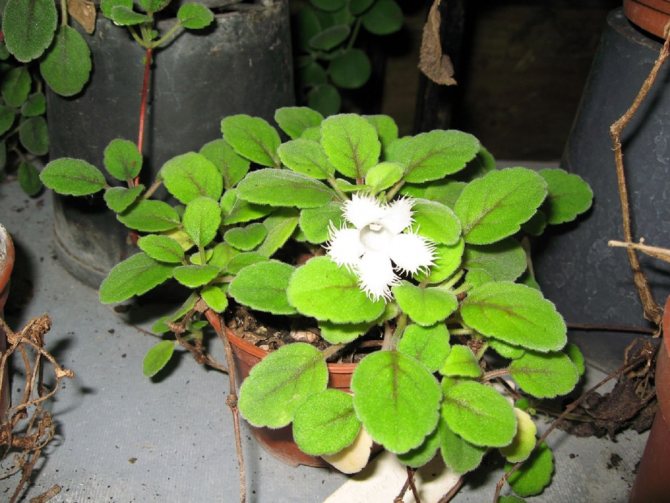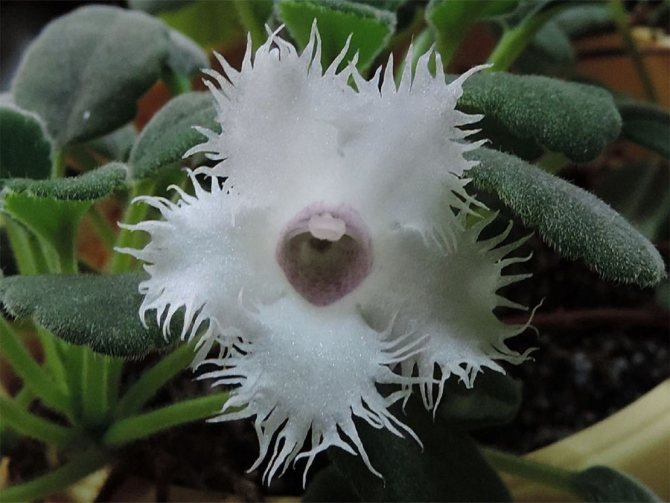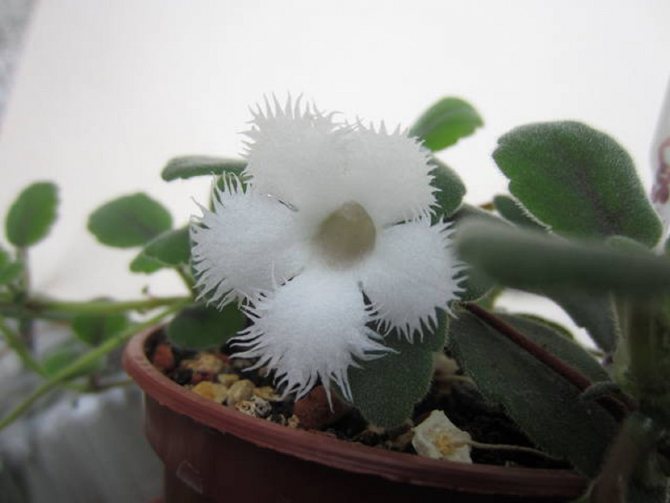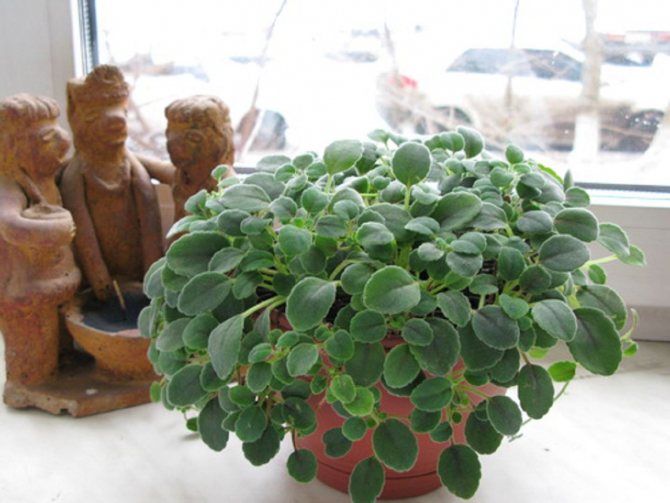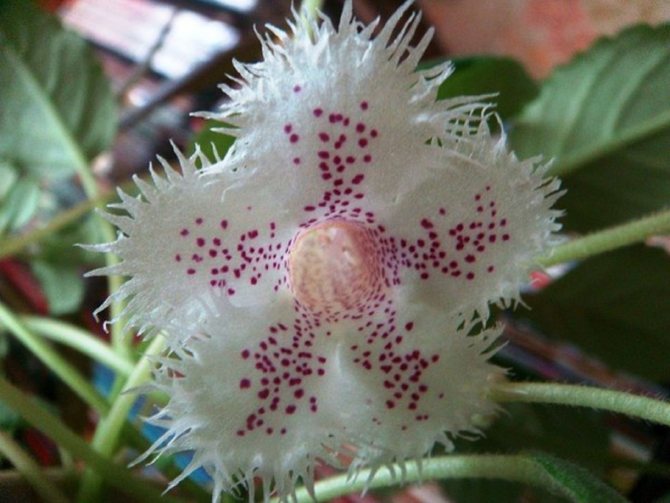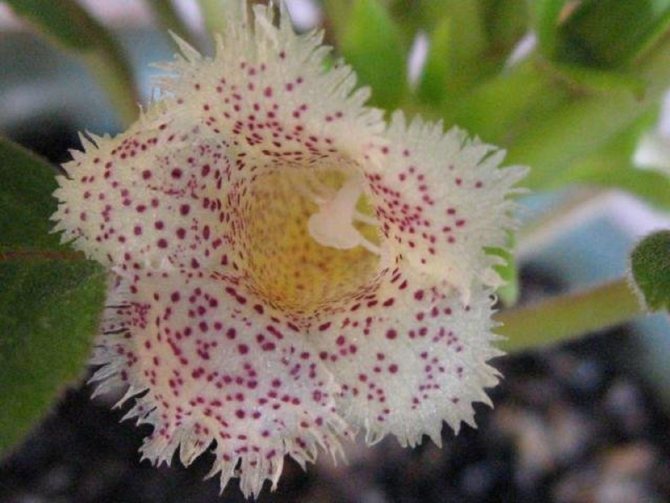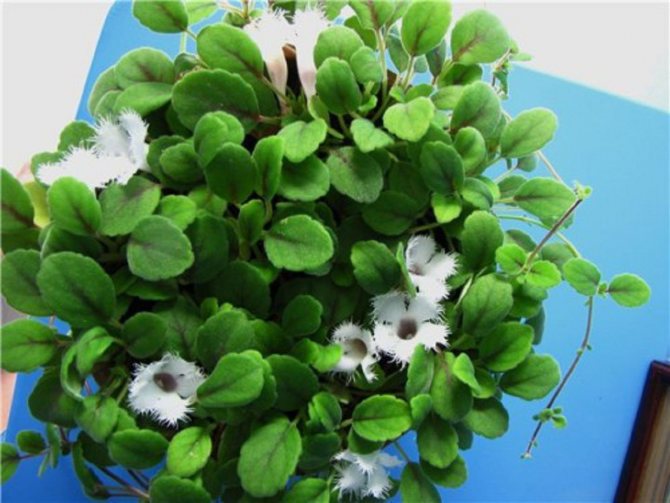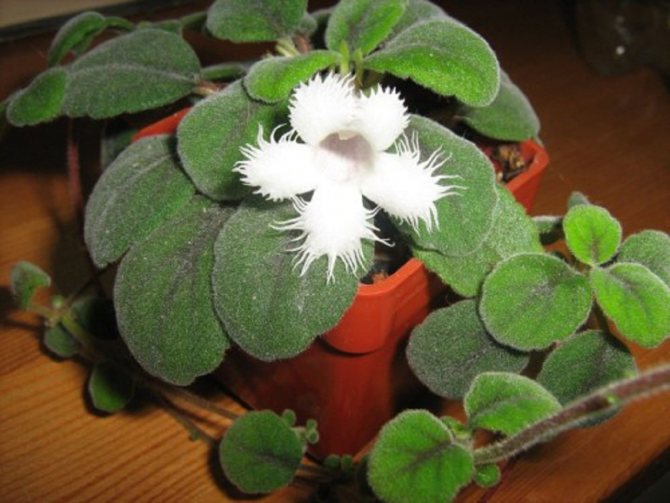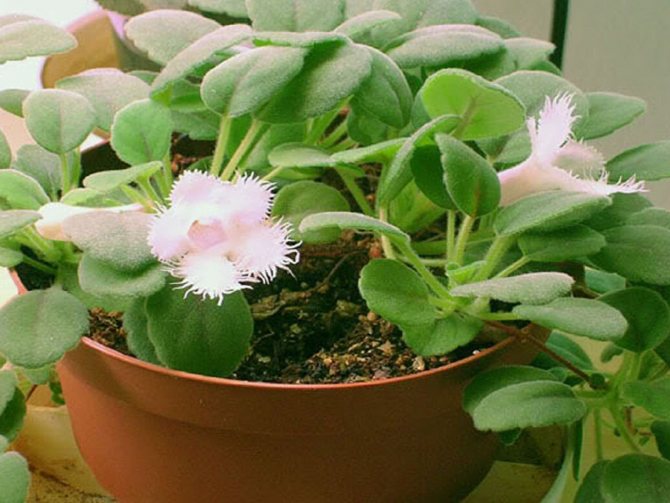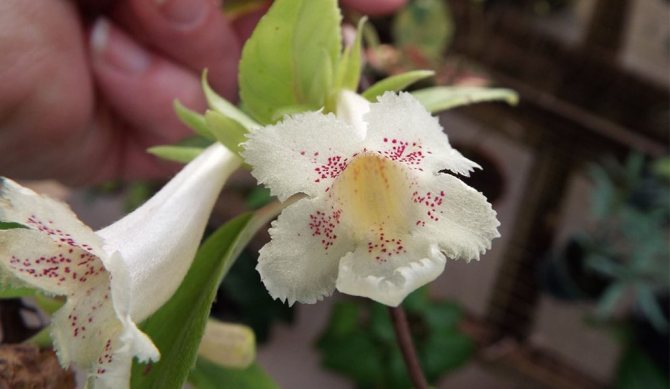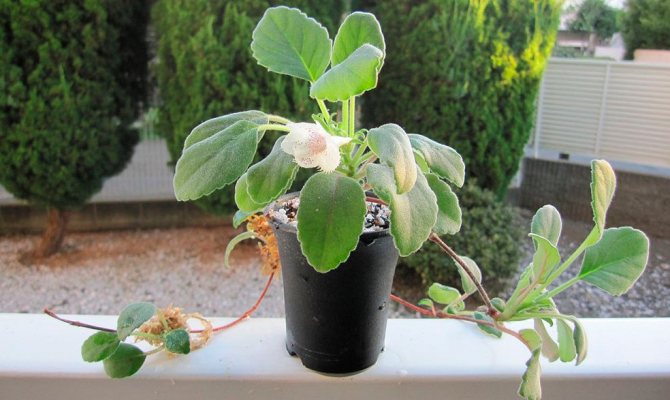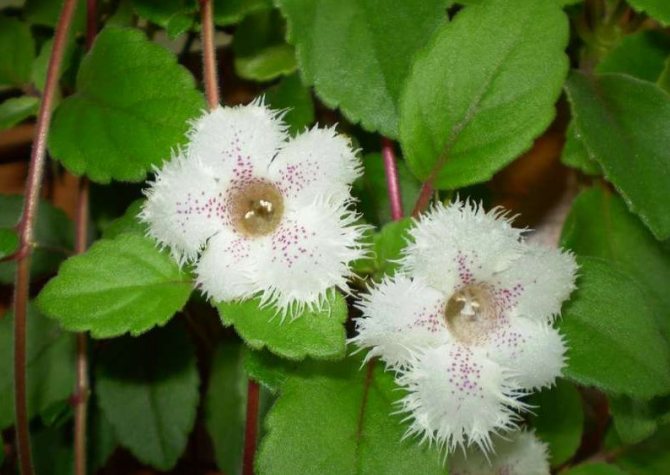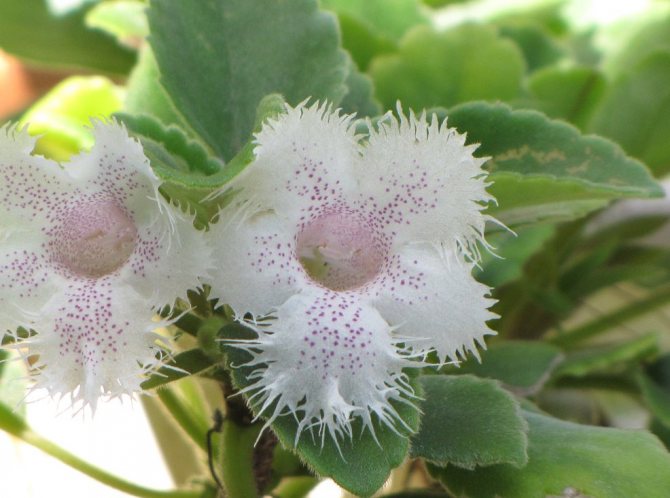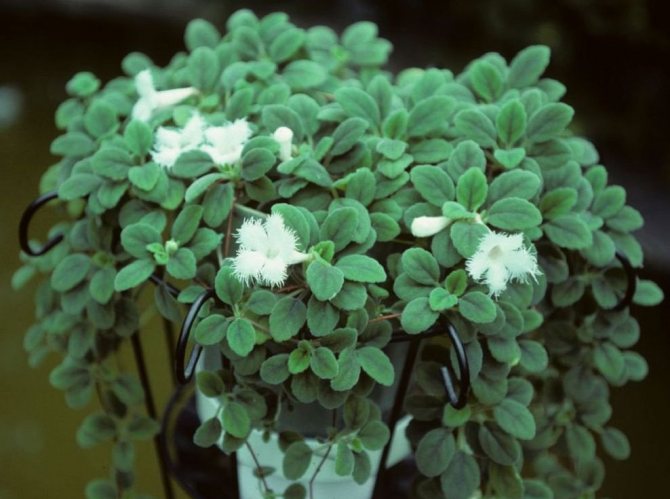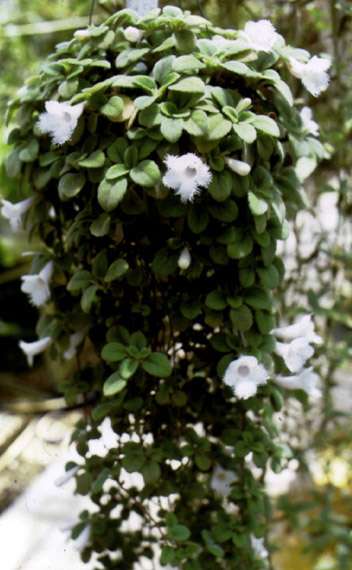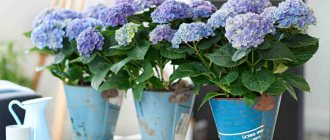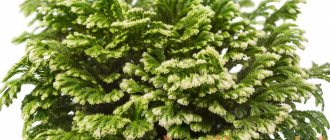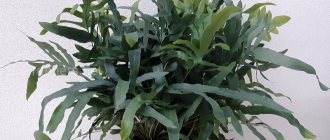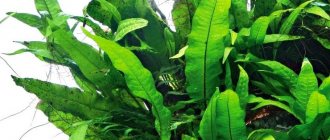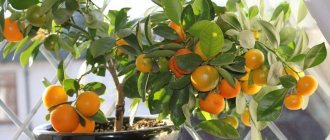Alsobia belongs to the ground cover plant species. This herbaceous flowering perennial can be found naturally in the tropical rainforests of Colombia, Brazil and South America. On the surface of the dark green oval foliage, there is pubescence, outwardly it is similar to the leaf plates of violets. This plant is also popularly called "lace flower", this is due to the fact that there is an unusual fringe at the tips of its petals.
The genus Alsobia unites only 6 species, but only 3 of them are cultivated indoors. Such a flower can be grown both in hanging pots and in basket pots. He does not require too much attention to himself, and if he is provided with proper care, then he will become a wonderful decoration for any apartment. At the same time, he will delight the grower with his unusual flowers for many years.
Alsobia grooming, care and maintenance
Illumination level of the room. The main thing to avoid when caring for alsobia at home is direct sunlight. They shouldn't light up the leaves. When choosing a place to place a container with a flower, you need to take into account the fact that he prefers, albeit bright, but diffused lighting. Excessive shading is contraindicated. The plant may grow worse or start to wither. This is reflected in the fading of the leaves and slow wilting. With the onset of cold weather and a decrease in daylight hours, it is necessary to provide additional illumination. A phytolamp is suitable as it. At this time, it is also worth moving the flower to the sill of the window, which faces the south side. But in order to avoid exposure to direct sunlight, shading is needed.
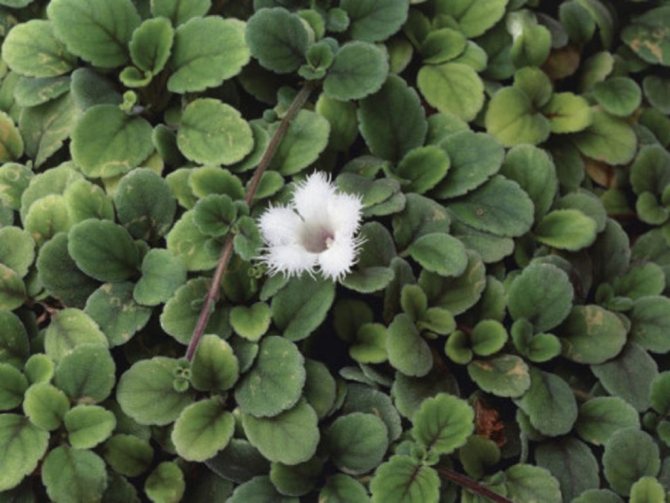
Indoor temperature. Houseplants alsobia do not tolerate drafts. Sudden changes in ambient temperature are also contraindicated. These factors can be detrimental to the flower. The optimal temperature range is considered to be the range from +18 to 25 degrees Celsius. At lower temperatures, the foliage fades and withers, gradually begins to fly around. The plant stops growing.
The plant is dormant from the beginning of November to the end of February. At this time, care should be somewhat different than in summer. The flower is resting, it lacks flowering and growth is greatly slowed down. During the dormant period, fertilizing cannot be done. Irrigation reduces both in frequency and in volume of water. The plant needs comfortable conditions (certain lighting, temperature and humidity) to prepare for the new growing season.
Reproduction and transplantation
Alsobia is propagated by seed and vegetative methods. You can buy alsobia seeds in special stores, but they germinate quite hard and require a lot of effort. It is much easier to grow a new plant by layering or rooting apical cuttings. A young outlet can be cut off and immediately buried in the ground or dug in without cutting it off from the mother plant. Roots are formed within a few days or a week. To make the rooting process of the cutting of alsobia faster, greenhouse conditions are organized for it using glass or film. After 1.5-2 weeks, the greenhouse is removed and an independent plant is transplanted to a permanent place.
Periodically, the alsobia needs to be transplanted. This is done every 2-3 years as the rhizome grows.The optimal substrate for planting is a mixture of sand, perlite, sphagnum moss, vermiculite. Better to choose wide and flat pots, as the root system is shallow. A drainage layer must be laid on the bottom, which ensures the outflow of excess liquid so that the roots do not rot.
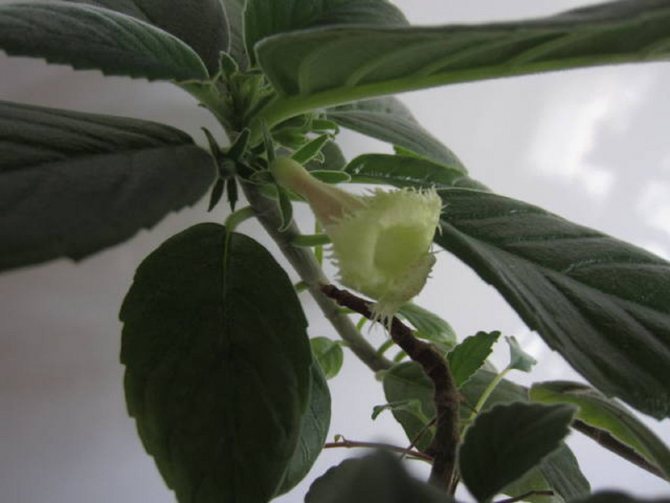

Maintaining moisture, how to water alsobia
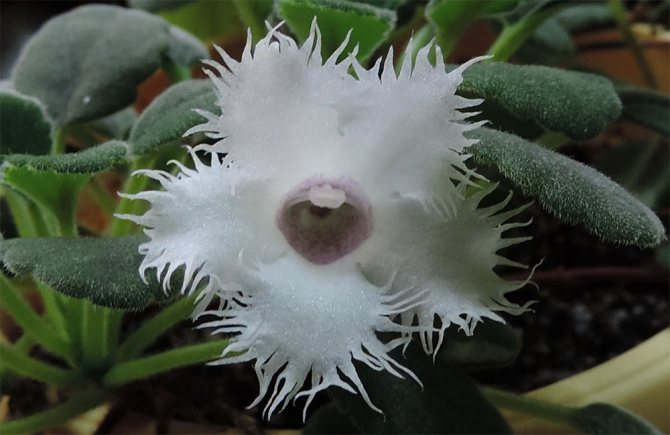

Indoor humidity. The presence of pubescence on the leaves excludes the possibility of moisture from the spray bottle. The ingress of moisture on the leaves of the foliage is fraught with the formation of rot. But home care for alsobia should include humidifying the air. For this, an open water-containing container is placed next to it. It is ideal to use a special household device - a humidifier. At low air humidity, the plant, in principle, grows and develops well. Unfortunately, the same cannot be said for flowering. Without proper air humidification, it turns out to be scarce.
If we talk about the topic of watering, then it is worth noting that alsobia indoor plants do not like excessively wet soil and frequent soil moisture. They need to be watered as needed when the top soil layer in the container dries up. Watering must be carried out at the root of the plant. The ingress of moisture on the leaves is fraught with the formation of rot. For irrigation, it is worth using melt water, which must first be defended. Its temperature should be about +23 .. 25 degrees Celsius. Normal growth and development of alsobia is possible only in slightly moist soil, in which there is no excess moisture. After watering, you need to wait for the water to drain into the sump and remove it from there. If the water is left, it can lead to the development of fungal diseases of the plant.
Description
Alsobia is distinguished by its compact size and attractive appearance. The plant has small oval-shaped leaf plates. Their color ranges from light to dark shades of green. The flowers are tubular and white in color. Flowering lasts a fairly long period from April to August.
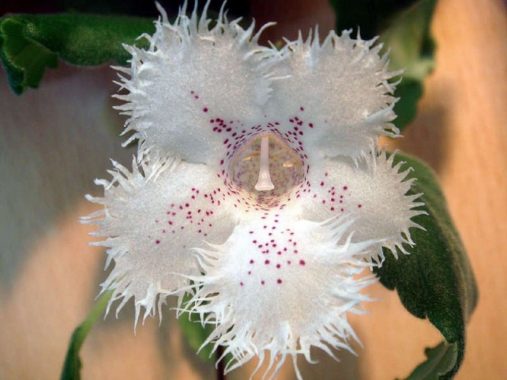

Alsobia does well when grown at home. Due to its decorative and spectacular appearance, perennials are used to decorate summer cottages, alpine hills, gazebos or ordinary rooms. It looks great in planters or pot arrangements thanks to the hanging stems.
How to feed and prune a plant
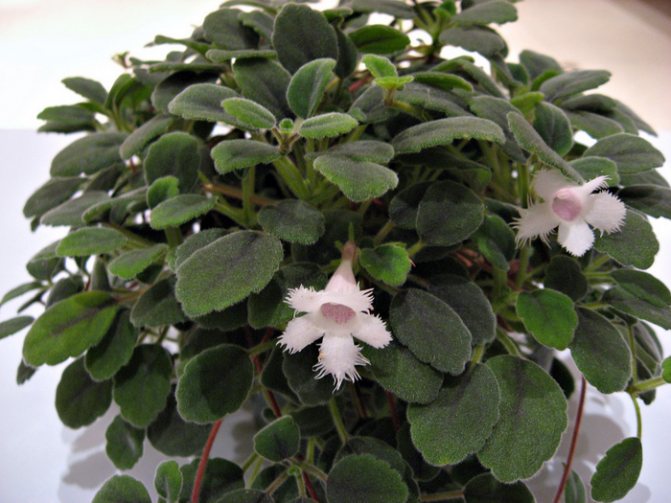

The correct development of indoor plants of alsobia is impossible without feeding. It must be applied to the soil during the period of active growth. It takes place from spring to late summer. As a feeding material, you can use a commercial fertilizer for violet flowers. It is sold in flower and garden shops.
Particular attention should be paid to the concentration of this fertilizer when creating a solution. For alsobia, it should be two times less than the manufacturer's recommended concentration for violets. The plant needs to be fed once every half a month.
The most beautiful plant, alsobia, when caring for home, requires regular pruning. It allows you to form a compact bush with a neat crown. Unnecessary shoots, overly elongated stems are pruned. Timely removal of overgrown parts has a beneficial effect on flowering and an increase in the amount of foliage. A large number of lateral branches should never be removed. This can lead to a lack of flowering.
Transfer
The plant should be replanted as it grows. This is best done after two to three years. The most suitable time of the year is spring, when the active growth of new leaves only begins after the winter rest. During this period, formative pruning can also be carried out, pinching off overgrown shoots.
Important: The transplant is carried out by the transshipment method, while maintaining the integrity of the earthen coma.
When growing alsobia as an ampelous plant with stems hanging from a pot, you need to choose small pots for transplanting. For stationary placement, a normal, wider diameter pot will work. The decorative effect will be facilitated by placing several young rosettes at once in one pot.
Landing in the ground, transplanting


Planting and transplanting play a special role in the growth and development of indoor plants. Alsobia is no exception. For her, you need to choose the optimal potting mix. Florists with experience in growing this flower recommend a purchased mixture for violets as a substrate. It can be purchased at flower and garden shops. They also advise adding a small amount of river sand or perlite to it.
For indoor plants alsobia, the substrate can be made independently. The soil mixture should contain one part sand, one part peat, one part humus, and two parts deciduous soil. Mix the components well. You can improve the quality of the substrate by adding a small amount of special components. Namely charcoal, sphagnum and coconut fiber. They will significantly improve the structure of the soil. Charcoal will also serve as a disinfectant.
The substrate should have good friability and excellent moisture and air permeability. It is recommended to plant a plant in a container with a wide cross-section, but a small height. A low flowerpot, which requires drainage holes at the bottom, will do.
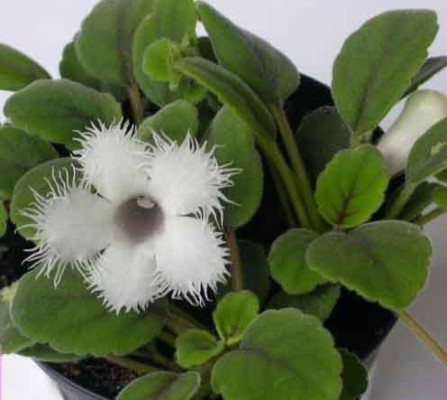

The plant does not develop as intensively as many indoor flowers. But still, home care for alsobia should include transplanting from container to container as the root system grows.
When the roots become cramped in the pot, the flower is transplanted. Usually, the frequency of transplantation does not exceed once every three years. For this purpose, you need to choose a container slightly larger than it was before. Of course, there should be drainage holes at the bottom. For good moisture transmission, the lower soil layer should be made of expanded clay. A loose drained substrate is poured over it. A small amount of moss and wood ash is added to it. They serve as disinfectants.
When choosing the optimal soil mixture with the recommended additives, the plant grows and develops effectively. It will also reduce the stress the flower experiences when transplanting.
Alsobia care at home
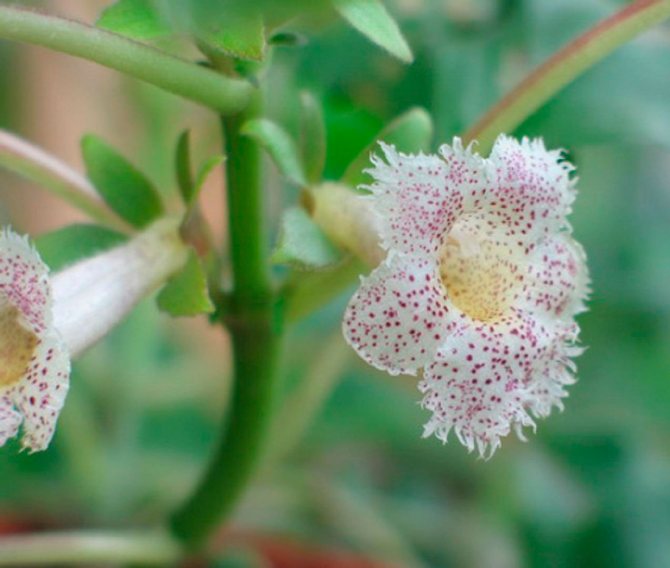

Illumination
Alsobia reacts negatively to direct sunlight. For its cultivation, it is recommended to choose places with bright diffused light. If the flower is in a shaded place, then it may suffer from poor lighting. At first, his foliage will become faded, and then the plant will slowly begin to die. From the second half of October, the length of daylight begins to decrease, so alsobia provide additional supplementary lighting, for this you can use a phytolamp. In winter, it is best to rearrange the bush on a sill with a southern orientation, while it should be shaded from the direct rays of the sun.
Temperature regime
The plant must be protected from drafts, as well as sudden temperature changes, because because of them it can die. The flower grows best at a temperature of 18-25 degrees. If the room is cooler than 18 degrees, then the foliage will become faded lethargic and begin to fly around, and the growth of the bush itself stops.
Air humidity
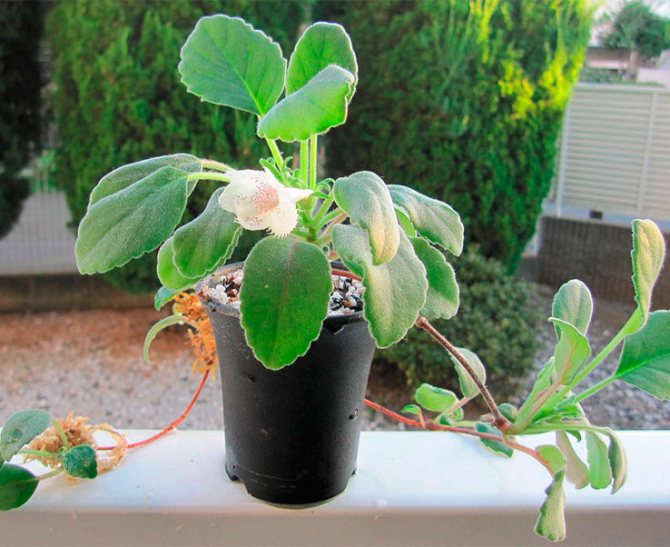

Since there is pubescence on the foliage of the alsobia, in no case should it be moistened with water from a spray bottle. If droplets of water get on the leaf plates, then because of this, rot may appear on them. In order to increase the level of air humidity in this case, it is recommended to use a household humidifier or an open vessel filled with water can be placed near the plant.At low air humidity, alsobia will be able to grow and develop normally, but flowering in this case will be more scarce.
Watering
Water the flower sparingly, and this procedure is carried out only if necessary, or rather, when the top layer of the soil mixture in the pot dries out. When wetting the substrate, pour the water gently under the root, otherwise it may fall on the surface of the leaf plates, which will cause rot on them. It is best to use well-settled or melt water, the temperature of which should be about 23-25 degrees. In order for the flower to grow and develop normally, the soil mixture in the container must be constantly slightly damp (not wet). Some time after the plant is watered, you need to drain the water that has accumulated in the pan. If it is not drained, this will lead to waterlogging of the substrate, which is the main reason for the development of various fungal diseases.
Substrate
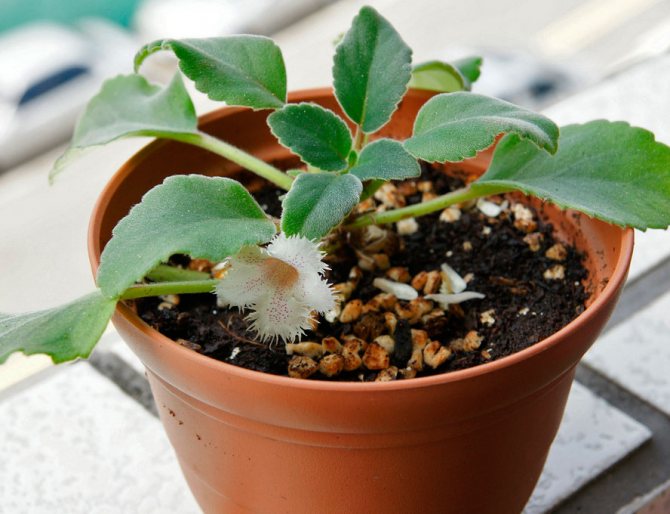

When planting or replanting alsobia, it is very important to use the correct soil mixture. Experienced flower growers recommend opting for a ready-made soil mixture for violets, which can be purchased at a specialized store. But before proceeding with planting, a little perlite or river sand must be added to the finished soil mixture and everything is mixed well. You can, if you wish, make a substrate with your own hands, for this, combine sand, peat, humus and leafy soil (1: 1: 1: 2). All components are well mixed and a small amount of sphagnum, coconut fiber and charcoal is added to the ready-made soil mixture to improve its quality. In addition to the fact that thanks to such additives, the structure of the substrate will become noticeably better, charcoal will also act as a disinfectant.
Alsobia can only be grown in a loose and light soil mixture that allows both water and air to pass through well. For planting, you should choose a low but wide pot, at the bottom of which there are rather large holes for drainage.
Alsobia transplant
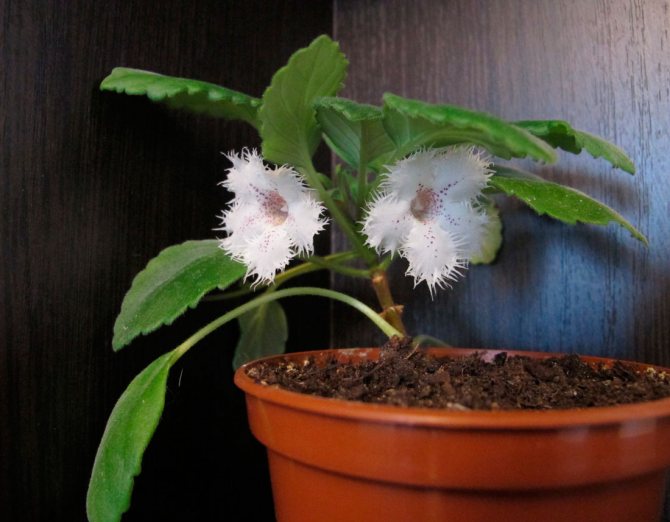

A flower transplant is carried out only if necessary, or rather, after the root system becomes too crowded in the pot. As a rule, alsobia is subjected to this procedure once every 3 years. When choosing a new container, pay attention to the fact that it should be slightly larger than the old pot. If there are no drainage holes at the bottom of the container, then, if possible, make them yourself. Also, at the bottom, it is imperative to make a good drainage layer, for this you can use expanded clay. The new soil mixture must be loose and well-drained (see above). In order to prevent various diseases and to disinfect the substrate, it is mixed with a small amount of wood ash and moss. If you use the correct soil mixture with the recommended additives, then a favorable microclimate will be created for the growth and development of the flower, and thanks to this substrate, it experiences less stress after transplanting.
Top dressing
Alsobia needs to be fed only during its active growth, which is observed in spring and summer. For top dressing, you can use ready-made violet fertilizer, which is sold in a flower shop. When preparing the nutrient solution, remember that its concentration should be 2 times less than that recommended by the manufacturer (see the instructions on the package). Top dressing is carried out regularly once every 15 days.
Bloom
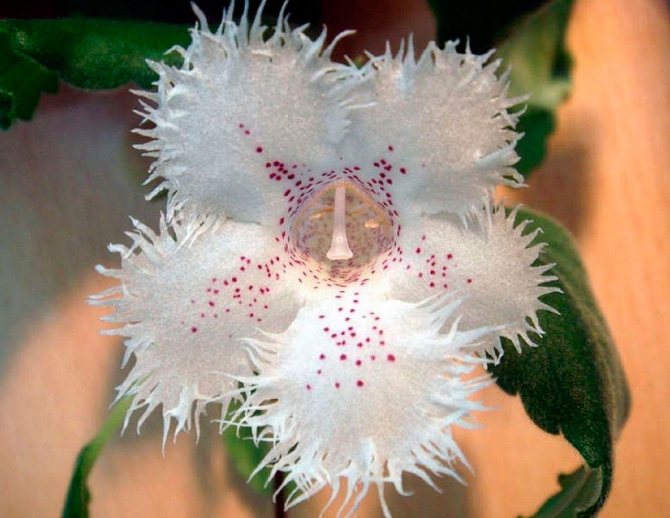

Alsobia bloom begins in April and ends in August. The color of the flowers depends on the species and variety, and can vary from pale green to coffee or white. In some varieties, the petals are decorated with specks of pink or red.All types and varieties of alsobia are united by the fact that the flowers have a fringe at the tips of the petals, making them look very unusual and spectacular.
Pruning
Thanks to regular pruning, the bush will always be compact and neat. Only unnecessary stepsons should be trimmed, as well as those stems that are too elongated. If you cut the bush in a timely manner, then it will have a beneficial effect on flowering, which will become more magnificent, and thanks to this, the amount of foliage will increase.
When pruning, remember that if too many side branches are removed, the bush may not bloom.
Winter care
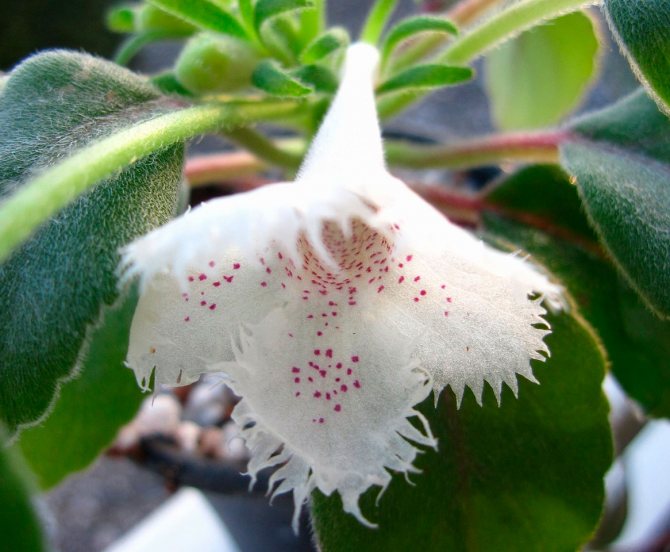

From the first days of November to the last days of February, the alsobia has a dormant period. At this time, you need to look after her a little differently than during the period of active growth. As a rule, during the dormant period, the growth of alsobia becomes very slow, and it does not bloom at this time.
During the dormant period, fertilizers cannot be applied to the soil, and the volume and frequency of watering must be reduced. At this time, the plant is resting and gaining strength before the new growing season, in this regard, you need to try to provide it with proper care so that it feels comfortable.
Flowering period
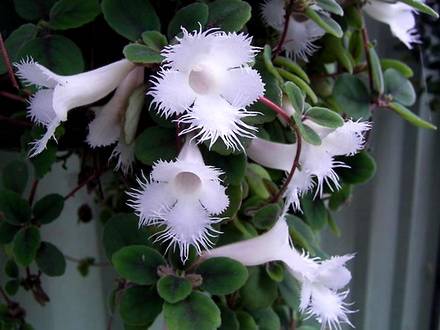

With proper care, the plant blooms quite luxuriantly. Flowering begins in April and lasts until August inclusive. Each species and variety of alsobia has a special color of flowers. Shades range from pale lime greens to coffee and whites. Some varieties have flowers with pink or red spots. All plant varieties have a similar trait. The tips of their petals are fringed. Along with the unusual shape, this looks especially impressive.
Types and varieties of alsobia with photos and names
Alsobia carnation
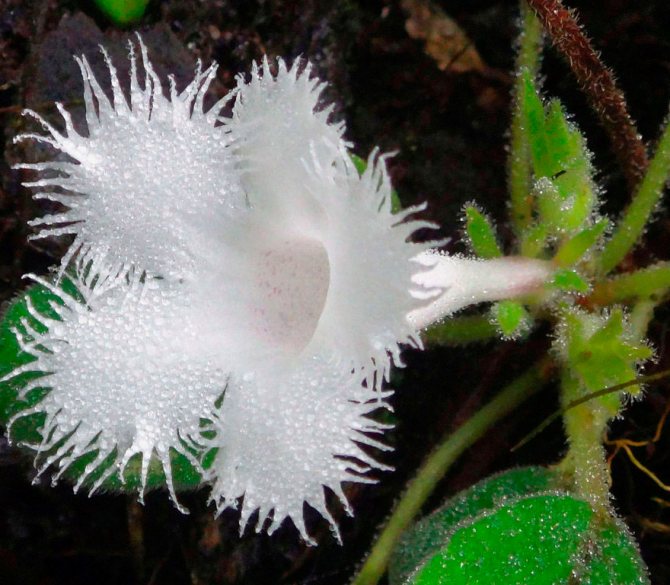

This ground cover plant has rather short stems, they are covered with small leaves of a dark green color, the surface of which is slightly pubescent, and their edge is jagged. Shoots are pale brown. The lace flower has a snow-white color, and there is a small fringe on the edges of its petals.
Alsobia point
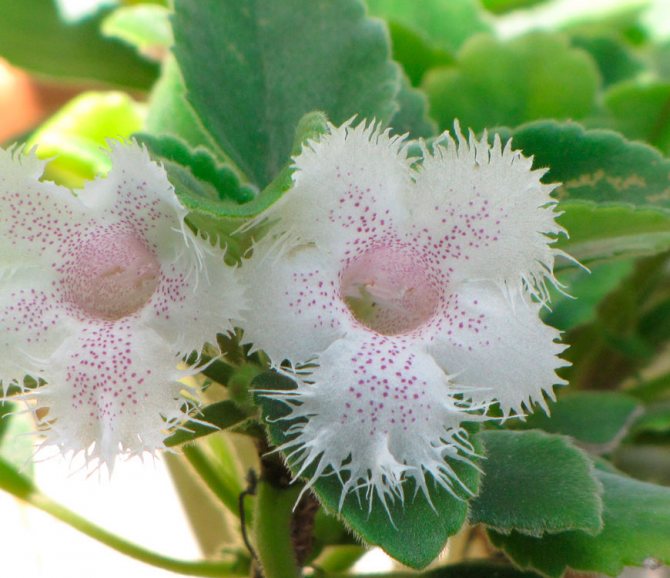

The punctata variety has a lignified, straight stem. Flat oval leaves have a slight pubescence of a light color, and serrations are located on the edge. The flowers can be painted light green, white or cream, and are decorated with pale pink or red specks.
Alsobia will sign
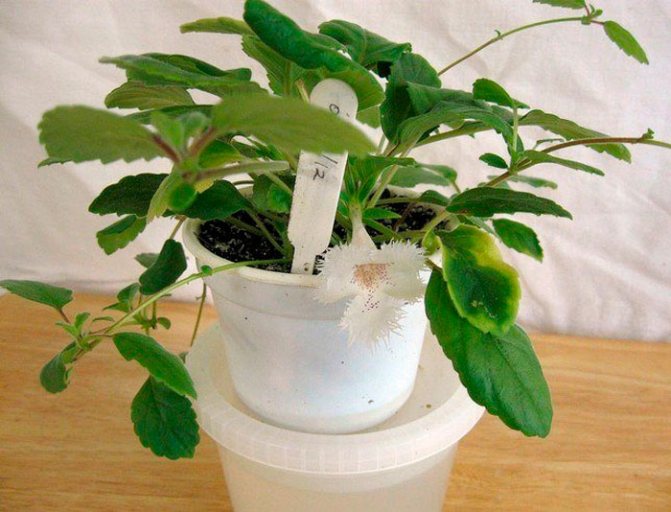

This hybrid variety was specially created for cultivation at home. The bush is decorated with large leaves with a jagged edge, they are painted in greenish color, and there is a slight pubescence on their surface. The pharynx of a flower is decorated with small specks of red or pink color; there is a fringe on the edge of its white petals.
Alsobia San Miguel
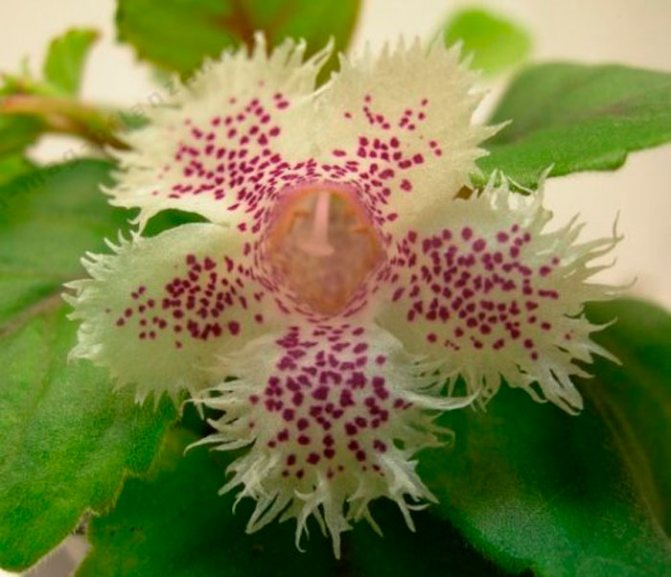

This variety was also bred specifically for indoor cultivation. On the surface of large bluish-green leaves there is pubescence, their edge is serrated. There is a fringe on the tops of the petals of white flowers, and their throats are decorated with specks of a red or pink hue.
Alsobia chiapas
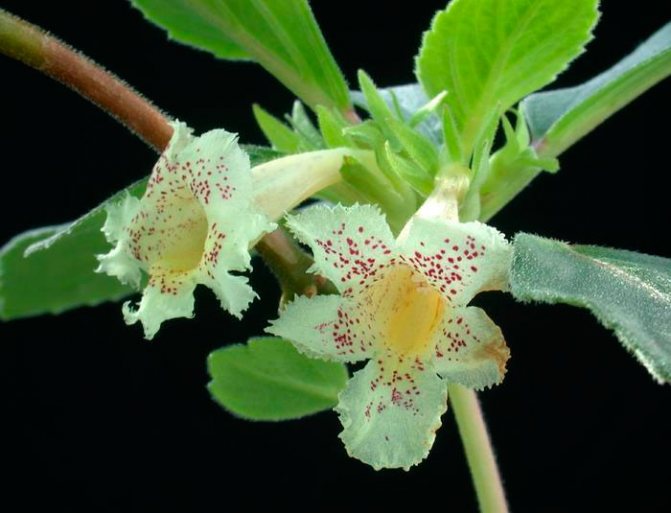

This hybrid variety is represented by a medium-sized shrub. The bush is decorated with large oval leaves, on the surface of which there is a slight greenish pubescence. The flowers are painted white or cream, with a spectacular fringe on the edge of the petals, and they are also decorated with small red dots.
Reproduction methods
The most beautiful indoor plants alsobia can be propagated by cuttings or seed material, daughter rosettes. Florists usually use cuttings or daughter rosettes.
Propagation by cuttings. For grafting, leaf or apical material is used. Cuttings are cut and planted for rooting.For this, prepare a light soil mixture with good looseness. In order for the roots to appear on the handle as soon as possible, it should be placed in greenhouse conditions. For this purpose, a mini-greenhouse is made. Under these conditions, the roots will grow back in about a month. When the roots are at least ten millimeters long, the cuttings can be transplanted into separate containers.
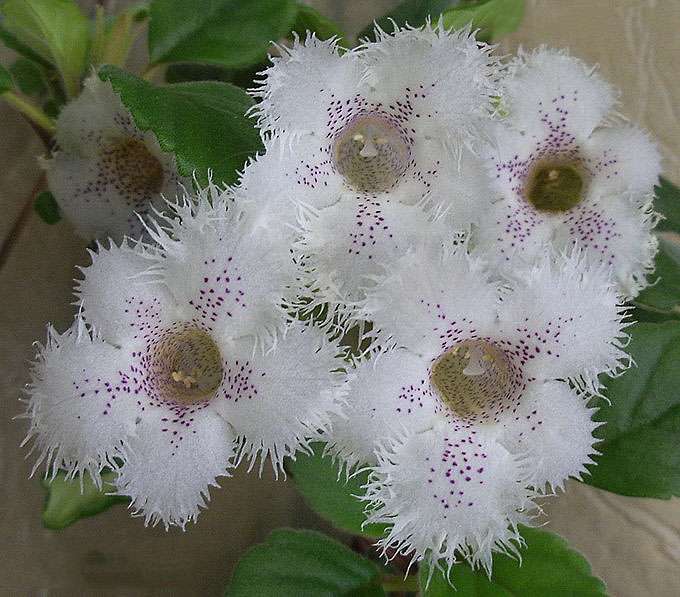

Reproduction by daughter sockets. They do not have to be separated from the bush. For reproduction, the daughter rosette is pinned to the surface of the soil directly in the pot near the parent plant. The roots will appear in a few weeks. If the florist nevertheless decided to cut the outlet, then it is planted in a container with wet sphagnum or sand. For faster rooting, it is placed in a mini-greenhouse. Its microclimate will promote active root growth. They will grow back to the correct size in about four weeks. After that, the plant is transplanted into a pot with soil mixture, as for the usual planting of alsobia.
Reproduction
There are four options for plant propagation: seeds, cuttings, layering and rosettes. The most effective way, which is guaranteed to produce a strong and viable plant, is through propagation using rosettes. The rosettes are cut and placed in the ground. You can make a mini-greenhouse, which should be placed in a warm place. In less than a month, sprouts will appear. When their height reaches 2-3 cm, they can be transplanted into separate containers.
Less time consuming will be the way in which the shoots of the alsobia descend closer to the ground. They take root and after a while they turn into an independent and full-fledged plant.
What difficulties are there when growing and keeping alsobia
Despite the fact that caring for alsobia at home is not difficult, the plant is still susceptible to certain diseases and attacks of insect pests. By the way, the flower is highly resistant to various ailments. Problems arise mainly with improper care or inappropriate conditions for growth.
Pest insects attack the plant when the indoor humidity is too low. In such conditions, spider mites or aphids, as well as scale insects, may appear. To destroy them, a solution of an insecticidal drug called Aktellik is used. They should spray the bush according to the instructions.
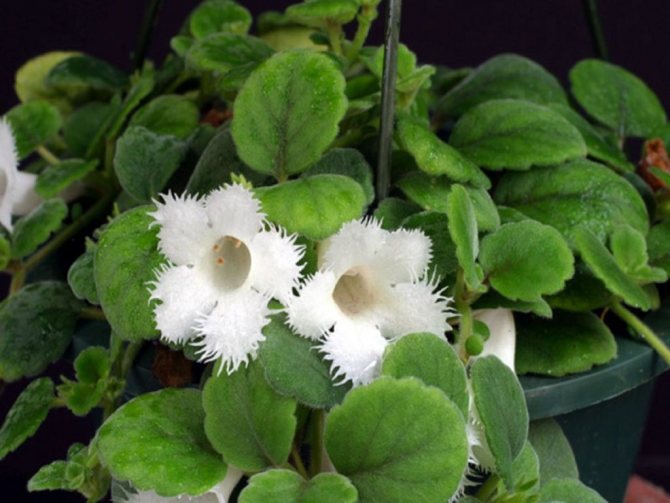

When exposed to cold water that gets into the soil, foliage can begin to wilt. The surface of the leaf plates is covered with dark spots. To avoid this, only warm water should be used when watering.
Flying around buds that have only recently formed, wilting of opened flowers occurs when there is a lack of moisture. In this case, it is necessary to increase the abundance and frequency of watering.
Rot on the roots, leading to the death of the entire alsobia bush, arises from excessive soil moisture. Direct sunlight leads to the appearance of dry brown spots on the surface of the leaf plates. To avoid these effects of sunburn, it is worth shading the plant.
The indoor flower alsobia is quite easy to care for. He tolerates home conditions very well. With proper care, it effectively grows and develops, it blooms magnificently with flowers amazing in shape and shades.
Diseases and pests
Most often, alsobia is affected by a spider mite. If large leaves change color and turn yellow, then there is no cause for concern. This process is due to the aging of the flower. The appearance of dried areas on the leaves indicates the destructive effects of sunlight. A plant in an excessively dark place slows down the growth rate, the leaves become small. The lack of moisture turns into drying out of the leaves, and its excess threatens with decay and the fact that the plant will rapidly turn yellow.Competent landing and care according to all the rules will avoid these problems.
Brief instructions for the care and maintenance of alsobia
| Temperature | In the summer period from + 18 to 25 degrees Celsius |
| Illumination | Bright diffused light, shading from direct sunlight |
| Humidity | The plant loves high humidity, but foliage should not be sprayed. Humidification is performed using a household device or a container of water is placed near the plant pot |
| Watering | Watering is performed when the upper layer dries up with water at room temperature under the root of the plant. Excess water accumulated in the sump should be removed |
| Priming | Sand, peat, humus and deciduous soil are used as the main components of the substrate. |
| Transfer | The transplant is performed as the root system grows, as a rule, once every three years. |
| Reproduction | Cuttings, seeds, daughter rosettes |
| Pests | Spider mites, aphids, scale insects |
Description and characteristics
Alsobia is a ground cover, creeping perennial with soft reddish stems. Belongs to the Gesneriev family and prefers shady South American forests. In a short time, it is able to form a continuous flowering carpet. It quickly grows shoots, with the help of which it spreads over the adjacent territory. Under natural conditions, the length of the mustache can reach 2 m.
Alsobia is a herbaceous perennial plant with oval green leaves. There are varieties with light and dark green growth. On the upper part of the leaf blade, dark veins and a large number of short villi are noticeable. On the stem, at a distance of 5-15 cm from each other, compact rosettes of leaves with a diameter of up to 15 cm are formed.
Single alsobia flowers are tubular in shape with a fringed edge. The color is most often snow-white or with red spots. The length of the tube varies in the range of 3-6 cm, the opened rim is 2-5 cm in diameter.
Varieties of alsobia
As indoor plants, two types are grown: carnation and spot, as well as hybrid varieties.
| Type, variety | Description | Leaves | Flowers |
| Clove-flowered (dayansiflore) | Small. Thickened sturdy stems and shoots. | Oval round dark. | Pure white with fringes. They look like a carnation. |
| Spot (speckled, punctate) | Differs in slow growth. Rare. | Elongated, juicy grass color. | A milky shade with lilac dots and a yellow throat, cut at the ends. |
| Signet (young swan) | Obtained by crossing carnation and spot. | Ovate, large, fleecy, serrated, light green. | Snow-white, on each petal there is a strip of pink dots, corrugated along the edges. |
| Chiaps | Kustovoy. The rarest variety. | Quite large, light green, elongated-oval, pointed. | The color of baked milk with a lemon center and red dots. |
Reproduction of Alsobia:
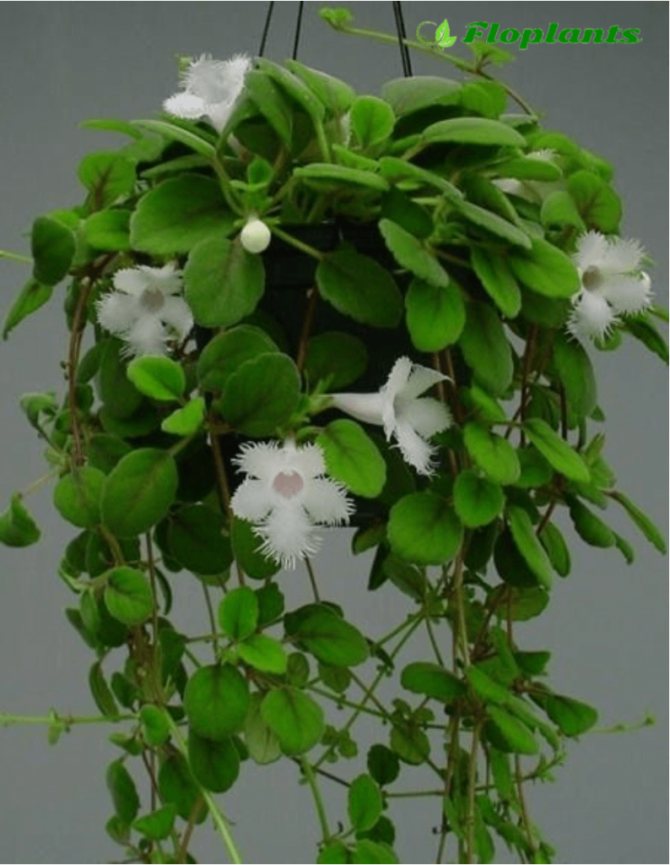

Alsobia Dianthiflora.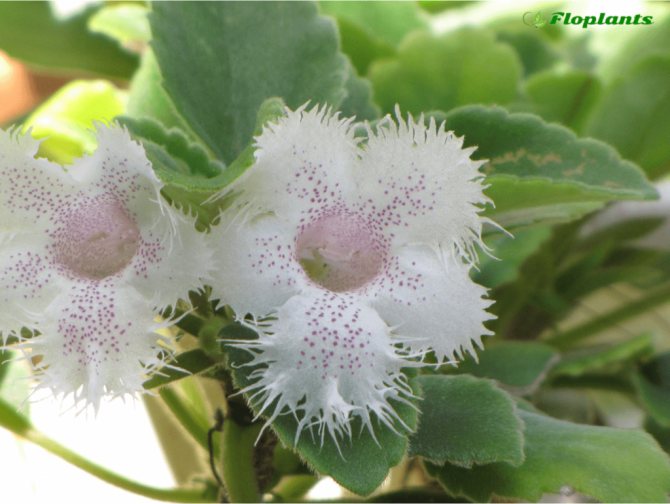

Аlsobia Cygnet.
Propagated by rooting cuttings, leaf and apical cuttings, seeds.
The plant reproduces very easily by layering obtained during the formation of the plant. For rooting, choose rosettes that are located as close to the mother plant as possible. After you have chosen the outlet, it must be dug in and covered with cling film or a bag to create a greenhouse. Several outlets can be rooted at the same time. Rooting takes place easily in water with the addition of activated carbon.
Reproduction can be carried out and immediately separating the antennae together with the outlet, dropping it into the soil and covering it with a bag.
It is laborious to propagate Alsobia seeds, the method described above is faster and more effective.
Propagation by leaf or apical cuttings is also fairly easy. Cuttings are carefully cut and planted to take root in light soil under the greenhouse. Rooting lasts for a month.
Views
There are several species in the genus Alsobia.
Alsobia San Migel
Flowers and foliage are large in size. The snow-white petals are adorned with bright crimson dots.
Alsolbia Cyqnet (Signet)
Translated from English as "young swan". White flowers have fringed petals. The leaf plates are serrated, with slight pubescence. The diameter of the rosettes reaches 8 centimeters.
Alsolbia puncante (Spot)
Distinctive features are the presence of a straight stiff stem and oval flat leaves. The mustache is flexible and hanging loose. The flowers are white, have a cream or light green shade, and are located on short stalks. It grows very slowly.
Alsolbia dianthiflora (Clove)
Received the most widespread use. The name is given for the similarity to the carnation. This variety has shortened shoots, brownish stems. The flowers are white in color, fringed along the edges. Rounded rosettes.
Alsobia Chiapas
In natural conditions, it grows in the form of a shrub. The flowers are light green with bright reddish dots. The leaf plates are ovoid.
Variegated
Differs in unusual leaf plates with snow-white or lemon stripes along the edges.
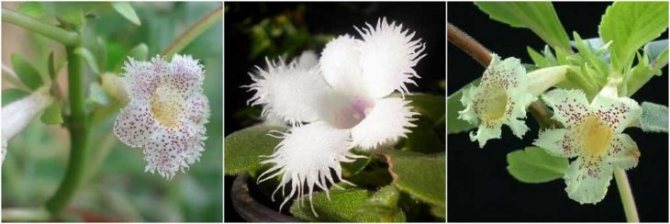

Possible difficulties
Alsobia is almost not disturbed by parasites and diseases. In rare cases, a spider mite, aphid, scale insect or nematode may appear. At the first sign of parasites, chemical treatment must be carried out and the affected shoots must be removed. After 1-2 weeks, the treatment is repeated.
The appearance of dark spots on the leaves may indicate excessive watering and the ingress of water droplets on the leaf plates. Withering or drying of the edge of the foliage indicates a lack of moisture and sunburn.
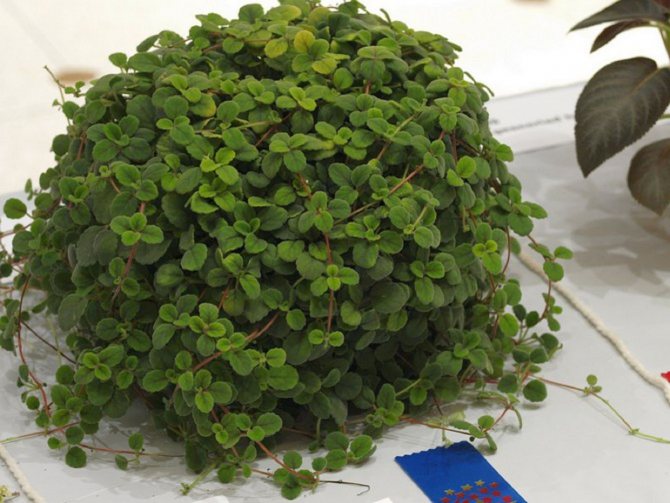

Alsobia pruning
Pruning is carried out in order to form a compact plant bush. When carrying out this procedure, you only need to remove strongly overgrown shoots and the so-called stepchildren.
If pruning is done on time, then the leaf cover becomes thicker, and the flowering is more abundant. However, if you remove more side branches than necessary, the alsobia may stop blooming altogether. Therefore, you should know when to stop and not delete unnecessary things.
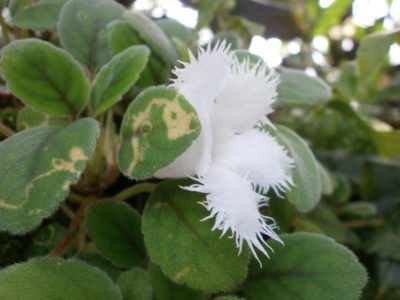

Alsobia in winter
From the beginning of November to the end of February, the plant begins a dormant period and care for it changes slightly. At this time, the growth of alsobia slows down to a minimum and it does not bloom.
During the hibernation period, you should reduce watering and stop feeding the plant. This time is necessary for him for a good rest before the growing season, therefore, during this period, the flower must be provided with careful care.
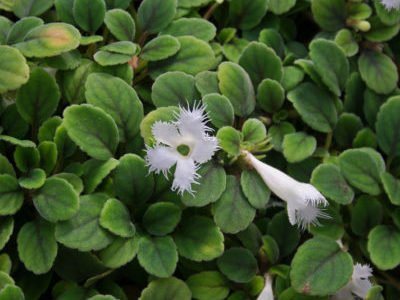

Fertilizer for alsobia
Top dressing is required only in summer and spring, that is, when the growing season begins. Fertilizers are suitable for violets. When using them, the concentration of the solution should be halved.
Fertilizers are applied twice a month throughout the growing season, with intervals of two weeks between each.
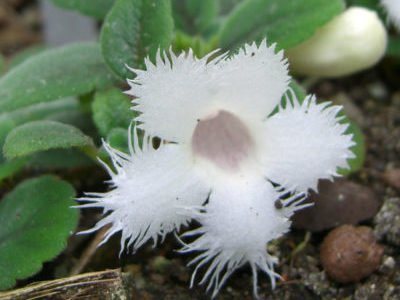

Alsobia for hanging pots
Flowering lasts from April to the end of August. From the leaf rosette, "mustaches" grow like those of strawberries, at the ends of which new rosettes are formed. The plant is able to grow in shaded areas without loss of decorative effect.
In indoor conditions, alsobia is most often grown in hanging pots as an ampelous plant for zoning and decorating arches, window openings, balconies, verandas, garden pavilions, creating individual decorative compositions that are suitable for the style of garden plots.
| Alsobia erect |
|
But there are also erect ones, for example, the alsobia Chiapas, originally from the Mexican state of Chiapas, with white vanilla flowers, the petals of which are decorated with purple specks. The petals of the flowers themselves have densely fringed edges bent back. Oval leaves, large with weak pubescence, are painted in a faint green color.
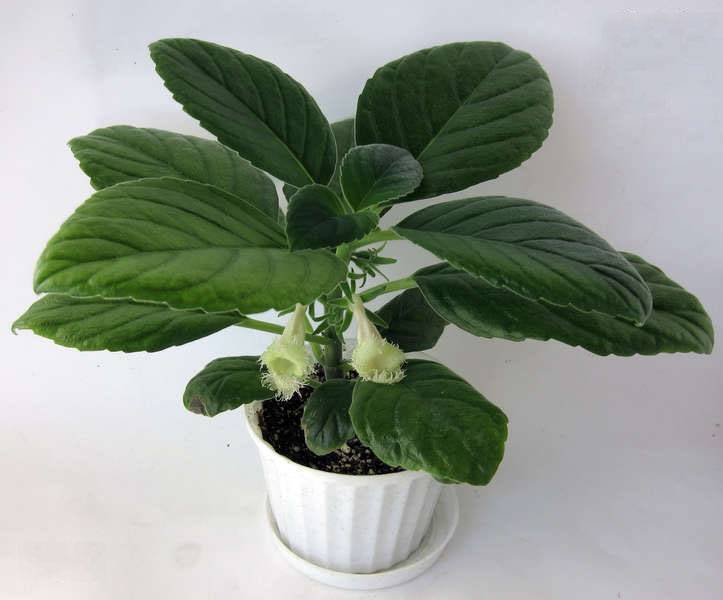

Much less often the plant is used as a ground cover on alpine hills in winter gardens.
In indoor floriculture, Alsobia punctata (Alsobia punctata) and Carnation alsobia (Alsobia dianthiflora) are most often grown.
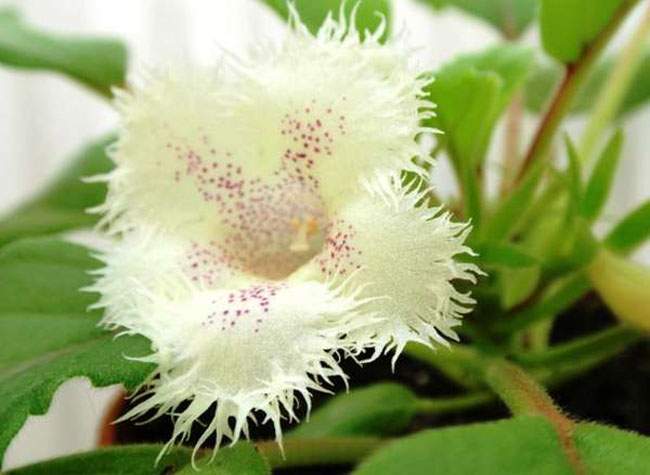

Alsobia punctata
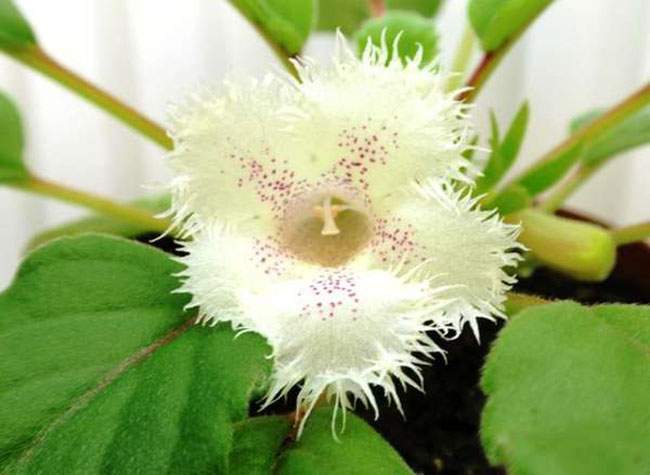

Alsobia punctata
The oval leaves of Alsobia speckled are covered with white villi. It blooms with large pubescent, cream flowers. On the inner surface of the petals, there are red specks.
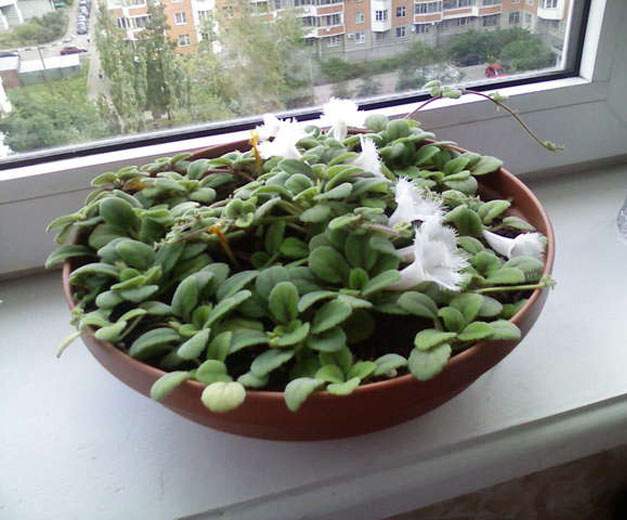

Alsobia dianthiflora (Alsobia dianthiflora)
In the herbaceous ground cover alsobia, clove-flowered leaves are small, oval, red veins are located on the dark green surface. The flowers are white, very similar to those of a carnation.
Growers are constantly creating new alsobia hybrids. The main area of improvement is the creation of larger flowers.
For room alsobia, the eastern and western rooms of the apartment are most suitable. The plant grows well in the northern rooms, but it blooms very rarely there.
Botanical description
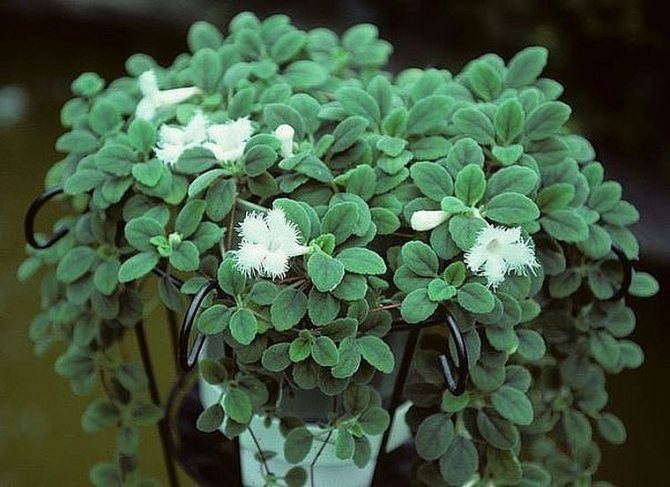

The family to which the alsobia belongs is the Gesneriaceae. Its velvety, oval leaves have different shades of green. Sometimes patterns appear on them in the form of specks or veins.
Alsobia flowers are white or pale pink in color, resembling a carnation because of the terry framing of the edges. They can be tubular or bell-shaped in shape. In the process of growth, a plant, like a strawberry, has a lot of whiskers, on which young shoots are formed. It blooms for several months, from early spring to early autumn.
Alsobia is grown primarily as an indoor crop. However, some gardeners prefer to decorate and plant alpine slides with it. To grow in open ground conditions, it needs a shady, humid place. But, unfortunately, this growing method is the least popular.
Indoor maintenance of a tropical beauty
In indoor breeding, the plant is used as an ampelous plant.
Home care, development and flowering can be ensured by following the rules:
| Factor | Conditions of year-round maintenance | |
| Spring Summer | Autumn winter | |
| Location / lighting | East, southeast windows. On others, they are highlighted, otherwise the plant will not bloom. Protected from direct sun. | |
| Temperature | + 19 ... + 25 ° C. Drafts and hot air from heating devices are contraindicated. Do not allow the soil temperature to drop below +17 ° C | |
| Humidity | Increased. Do not spray. Placed on a pallet with wet pebbles, moss. | |
| Watering | Moderate, uniform. After the top layer has dried, the inside of the soil must remain moist. | |
| Transfer | As the roots grow. Carefully, they leave the old soil on tender roots, adding a new substrate. | |
| Pot | Wide shallow. Drainage. | |
| The soil | Own preparation: leaf, humus, peat soil, coarse sand (2: 1: 1: 1). A small amount of moss, coconut fiber, charcoal is added. Ready - soil for Saintpaulias. | |
| Top dressing | Once every 2 weeks, fertilizer for flowering indoor plants (0.5 dose), violets (1 dose). | Do not contribute. |
| Pruning | Pinch regularly, cut off long shoots. Regulate the number of new outlets. | |
Watering alsobia
Watering the plant should be moderate. It should be carried out only when the need arises, or rather, only after the top layer of the substrate has dried. It is only necessary to bring water under the root, it should not fall on the leaves, otherwise they will begin to rot.
The water should be settled or melted with a temperature of 23 to 25 degrees. The soil in the pot should not be dry or waterlogged. It should be kept slightly moist. The liquid flowing into the pan after watering must be drained so that it does not stagnate and does not lead to the development of fungal diseases in the plant.
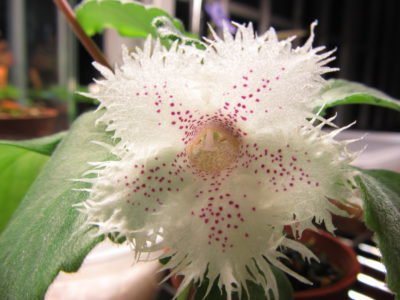

Crown formation and rejuvenation of alsobia at home:
In order for the plant to look as impressive as possible and the flowering was lush, it is necessary to pinch or cut off the overgrown shoots. Alsobia gives a lot of layering, so it is necessary to adjust the length of the mustache, cutting off the excess, making a more lush bush, which will allow the stepsons and the plant itself to grow large and create a dense ampel with flowering. Do the shortening of the mustache to your liking, but do not strive to form a very compact bush, this is fraught with the lack of abundant flowering.
Alsobia transplant
The flower should be transplanted when the roots braid the entire pot and braid with an earthen ball. It should take about three years from the moment of planting to transplanting.
The new alsobia pot should be more spacious than the previous one. Large holes should be made in it for drainage, and expanded clay should be placed on the bottom as a drainage layer.
The transplant soil should be loose and allow water to pass through well. You can use a ready-made substrate for violets or prepare it from humus, peat, sand and leafy soil.
To prevent the appearance of diseases and disinfect the planting soil, it is necessary to add moss and wood ash to it. A mixture of these components will create a favorable microclimate for plant growth and help it adapt faster after transplanting.
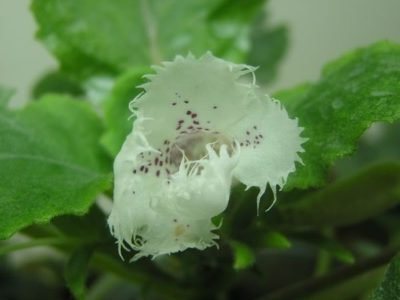

Description of alsobia
Previously, the plant belonged to the genus Episcia, but in 1978 it was identified as a separate plant. Leaves - a velvety oval of different shades of green with prominent veins, collected on a compact rosette 15 cm, no more. Flowers - tubular white with a delicate edge, bloom from April to late August.
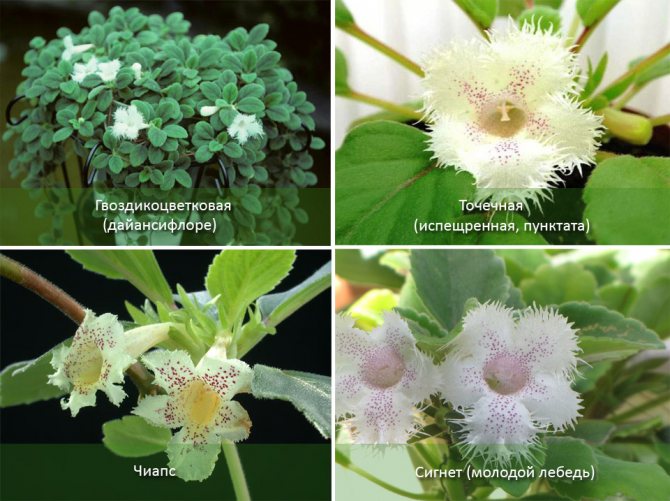

Shoots of two types: thick small and narrow long (whiskers). This is a type of creeping stem that produces a rosette capable of rooting.
Alsobia - snow-white lace flower


Family Gesneriaceae - Gesneriaceae.
Genus Alsobia - Alsobia.
Lace Flower, Vace Flower Vine, Lace Flower.
Alsobia - plant care, lighting, planting and transplanting, reproduction.
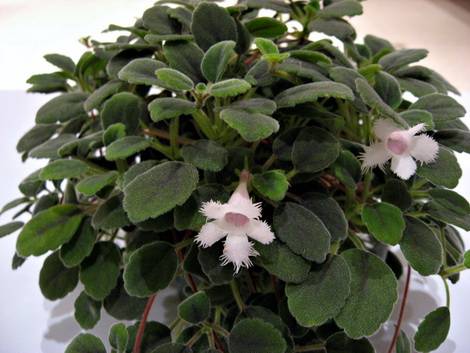

Alsobia, origin and appearance.
The natural habitat is the forests of South America (Mexico, Colombia, Costa Rica, Brazil). Translated from Greek, the name means “plant-grove”. In the shade of trees, these ground cover plants grow to form a dense carpet from delicate light shades to dark green. Adult specimens produce a large number of whiskers, on which new shoots appear. Stolons (whiskers with rosettes) are usually from 20 to 25 cm in length, daughter rosettes have a diameter of 6-8 cm. Then the shoots take root on their own and the alsobia thus grows in breadth.
Leaves in a round or oval shape are covered with a velvety short pile, sometimes they have patterns in the form of specks, veins and other various patterns. Dark veins are visible on the upper part of the leaf plate. Small green leaves of alsobia with purple veins, covered with fluff, are located very close to each other on short hanging shoots.
Single flowers of alsobia are usually tubular or bell-shaped, most often snow-white or with red spots and fringed edges. The length of the tube ranges from 3-6 cm, the open corolla is 2-5 cm in diameter. Flowering lasts several months in the spring and summer.
It grows rather slowly throughout the year. Alsobia, like its closest relative episode, in the lower leaf axils forms peculiar thin shoots with elongated internodes - stolons. On the stem of such a stolon, at a distance of 5-15 cm from each other, compact small daughter rosettes of leaves up to 15 cm in diameter are formed, capable of taking root and giving life to a new plant.
Alsobia, care and maintenance in room conditions.
The genus alsobia is represented by only four species, two of which can be grown at home.Especially widely cultivated is Alsobia dianthiflora (Alsobia dianthiflora), the flowers of which are easily distinguished by their numerous small burgundy dots and a very short, barely noticeable fringe. However, there are other varieties of alsobia that have much larger, brighter and more unusual flowers.
Alsobia is one of the unpretentious plants ideal for growing at home. It has a not very large rosette, with numerous mustache-shoots up to 20 cm hanging down, at the ends of which rosettes-babies grow and are effectively arranged in several tiers with flowers of white or pale pink color, similar to carnation flowers with a double frame. Most often, it is planted in hanging pots as an ampelous view, and it can also be planted as an auxiliary green decor in large flowerpots. It can be used to decorate a balcony or terrace.
With good maintenance, it will delight you for many years with its beautiful delicate flowers, spicy aroma and thick green cover. Even significant violations in the rules of leaving will not bring much damage to her.
In order for the plant to grow properly and please with a well-groomed appearance, you need to regularly pinch off too overgrown shoots up to 20-30 cm. Alsobia tolerates pruning well. They give a lot of stepchildren who hang in long garlands and intertwine with each other, so it is necessary to adjust the length of the stolon mustache and the number of stepsons, cutting off the excess. Pruning is used to form a compact alsobia bush. Overgrown stems with leaves, as well as extra stepsons, are subjected to this procedure. With timely pruning, the leaves of the plant enlarge, and the flowering is even more abundant. By trimming, pinching and interweaving the shoots, graceful garlands are formed.
If you remove many side shoots, then you can form a fairly compact bush, although there will be no abundant flowering. When a large number of lateral shoots are removed, the plant may stop blooming, so measure is needed in everything. With age, the plant loses its decorative effect, the leaves turn yellow and fall off, so alsobia requires regular rejuvenation.
Sometimes after flowering, capsules with seeds are formed, but usually, in order not to weaken the plant, the wilting flowers are promptly removed at the base.
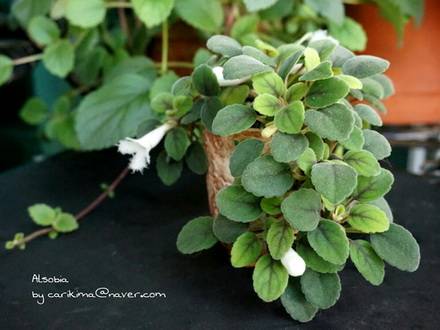

What should be the lighting for Alsobia.
Based on the fact that under natural conditions, alsobia grows in the forest shade, you should provide a diffused color for it, avoiding bright lighting. Also, do not place the flower on windows facing south, it is preferable to choose east or west windows, but protect from direct rays. In bright sunlight, the leaves turn yellow and curl. The plant takes root well on the north side, but it may not bloom.
It is best if the duration of natural light per day is at least 10-12 hours, which is most favorable for abundant and prolonged flowering. When the daylight hours are reduced, for example, in the autumn-winter period, it is worth providing artificial lighting, which the flower perceives very well. If you organize illumination for a period of 13-15 hours, alsobia will certainly delight you with unscheduled winter flowering.
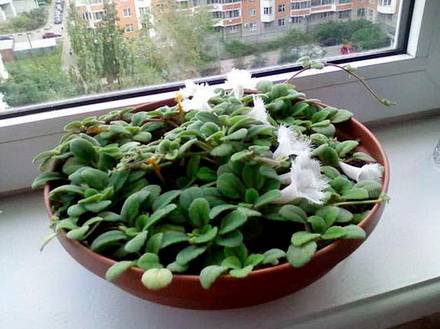

Optimum temperature.
Quite a thermophilic plant and requires a moderately warm content throughout the year at a temperature of 20-25 degrees. Temperature drops, as well as drafts are contraindicated. You do not need to place the flower near vents or batteries, as well as on a cool windowsill. When the temperature drops to 16-18 degrees, the plant may start to hurt, slow down its growth. Such a temperature can be partly acceptable only during the period of autumn-winter dormancy, when the plant is resting.
Pots for Alsobia.
To avoid waterlogging the soil, it is better to use low, but spacious pots. The drainage holes must be large.When growing alsobia as an ampelous plant with stems hanging from a pot, you need to choose small pots for transplanting. For stationary placement, a normal, wider diameter pot will work. When choosing baskets, it is advisable to give preference to plastic or made of hardwood. Otherwise, they will quickly rot.
In what substrate is Alsobia planted.
For growing, store-bought soil for violets is quite suitable, which must be slightly diluted with sand or perlite. The main task is to make the soil light and breathable, to let water and air pass well. Maintain the pH between 5.5 and 6.5.
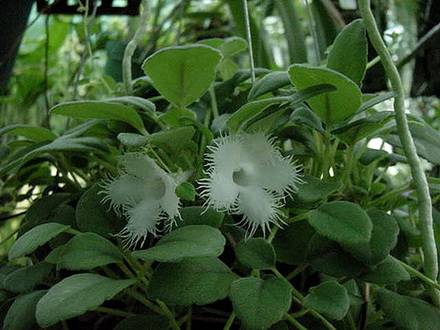

How to water Alsobia.
Uniform and moderate watering is required. It is necessary to carefully monitor the condition of the soil in the pot, making sure that it does not dry out. Waterlogging of the soil is also highly undesirable. Watering the plants is carried out in small portions, observing the drying of the top layer of the soil. The water must be poured just enough so that a small amount of it can seep through the drainage hole. Watering is carried out directly under the plant or in the pallet; water is not allowed on the leaf mass. This will require soft, well-separated water at room temperature.
Air humidity.
Frequent spraying with warm water will help maintain optimal humidity in the air where alsobia grows. The air around the plant should be sprayed, avoiding moisture on the flowers and leaves, as brown weeping spots may appear on the velvety leaves and flower petals. This is especially important in hot weather. This pleasant water treatment for the plant is very important for its well-being and active growth. Spraying not only moisturizes and purifies the air, but also lowers the air temperature in summer, creating more comfortable conditions. Both spraying and watering can be slightly reduced in winter, from about November to February, when the dormant period begins and vegetative growth slows down. If the humidity in the room is insufficient, the flower will slow down the growth of young shoots and may stop flowering. You can also put a container filled with water in the immediate vicinity of the flower.
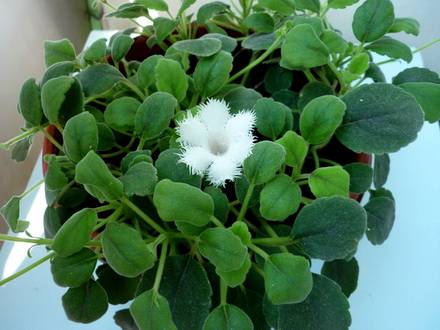

Feeding Alsobia with fertilizers.
It is advisable to feed the flower during the spring-summer period, during the period of active growth and development, once every two weeks using a complex mineral fertilizer for flowering plants. Organic fertilizers are not suitable for Alsobia. In winter, the plant is not fed. You should not exceed the concentration of fertilizers indicated on the package, and it is better to even slightly reduce the dose. Excessive feeding has a negative effect on the growth of alsobia. Fertilizers are applied to wet soil.
Planting and transplanting Alsobia.
The plant should be replanted as it grows. A transplant is necessary for alsobia only when the root system completely occupies the flower pot and entangles the entire earthen lump. This can happen approximately every 2-3 years. The most suitable time of the year is spring, when the active growth of new leaves only begins after the winter rest. During this period, formative pruning can also be carried out, pinching off overgrown shoots. The transplant is carried out by the transshipment method, while maintaining the integrity of the earthen coma. When planting, the decorative effect will be facilitated by placing several young rosettes in one pot at once, then the bush will be fluffy.
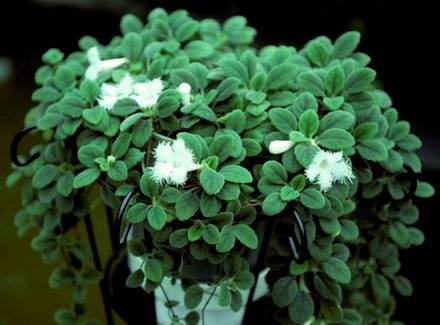

Propagation by cuttings and daughter rosettes.
Alsobia is quite unpretentious for rooting. For reproduction, not only leafy cuttings, but also apical cuttings are suitable. They are carefully cut and planted in loose soil in a closed container, similar to a mini-greenhouse. The roots of a young plant appear, depending on the ambient conditions and temperature, in about 2-3 weeks, sometimes longer.Cuttings and rosettes take root almost always, even if you have to wait more than a month. Young plants are transplanted into individual flower pots when the roots grow up to at least one centimeter in length.
You can also try leaf cuttings, choosing for this a large and healthy leaf with a petiole, and planting it in a light substrate or in sphagnum moss. Roots are formed after 3-4 weeks. To speed up the process and increase the likelihood of rooting, it is recommended to use mini greenhouses.
The rosettes are cut from the parent specimen directly from the main plant and rooted in a separate pot. The cut off young rosette should be placed in a mini-greenhouse with a suitable soil containing sphagnum moss, sand, perlite, etc. Already after 2-3 weeks, roots may appear. The term will depend on environmental conditions. It can increase up to one month, which is quite normal.
Rooting is also possible without cutting off the rosette from the plant. To do this, a branch with a rosette must be pinned to the soil, buried slightly with soil and covered with foil. You can dig in a few rosettes in a pot next to the mother plant, put the tendril around, so that the bases of the rosettes on it touch the ground. Fill the pot with substrate almost to the top, leaving room for watering. In such contact with the ground, young roots will appear very soon. But at the same time, it is not advised to separate the sockets; you should root the sockets located as close to the mother plant as possible, because rosettes on too long whiskers are more difficult to root. And it is better to put the pot for them next to the mother's and bend them to the ground. The separation is carried out only after the rooting of the outlet is complete.
Reproduction by seeds.
You can buy alsobia seeds in special stores, but they germinate quite hard and require a lot of effort.
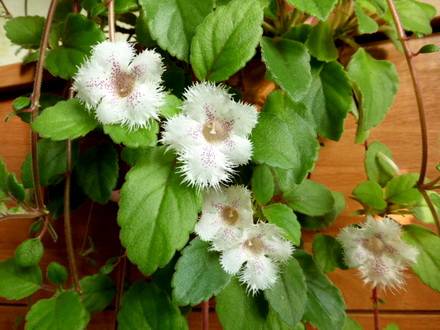

Rest period.
Alsobia does not have a pronounced dormant period. However, in winter, from November to February, she rests for 8 or 12 weeks. Reduced vegetative growth is observed, there is no flowering. At this time, the flower does not need to be fed, and watering should be poor. It is best to give the plant a full rest without disturbing it.
Diseases and problems in caring for Alsobia.
Most often, the plant is sick due to improper care.
For example, dry indoor air can provoke the appearance of spider mites, aphids or scale insects. In such cases, plants are immediately treated with insecticidal solutions.
When watering a plant with water with a temperature below 18 degrees, spots may appear on the leaves.
With an insufficient amount of moisture in the soil, alsobia sheds buds and flowers and takes on a withering look.
With excessive watering or stagnation of water in the soil, a gradual decay of the roots occurs, which can lead to the death of the entire plant. An excess of water is especially dangerous during the cold season.
When the plant is in direct sunlight, the leaves can get burned in the form of drying spots. Areas of dry tissue on the leaves are the result of sunburn.
Large leaves of the plant can turn yellow, which is a natural aging process.
With a lack of light, the plant grows slowly, the stems stretch out, and the leaves become smaller.
The leaves curl up, and their tips dry out in dry air.
Popular types and varieties of Alsobia.
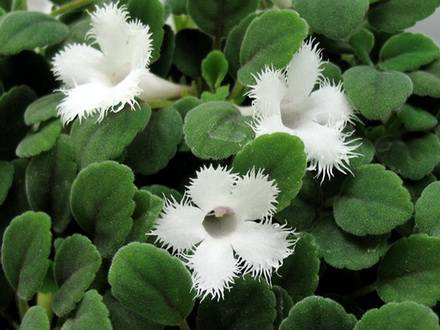

Alcobia dianthiflora - Alsobia dianthiflore, clove... This compact variety is the most widespread. A medium-sized plant with small (up to 2-3 cm) dark green pubescent leaves of an oval or round shape with small notches along the entire edge, up to three centimeters in length. Shoots are short but strong, brown in color, the stems are also quite thick and strong. She releases a mustache, on which young rosettes of leaves 5-6 cm in diameter are formed. Pruning the shoots on the first or second pair of rosettes gives a beautiful chunky shape and stimulates flowering.
The flowers are usually white, the edges of the flower are profusely fringed along the edge. The flower vaguely resembles a carnation flower, for which the plant got its name. Snow-white flowers are formed in large numbers, but each bloom lasts only a few days. The edges of the petals are carved with delicate fringes.
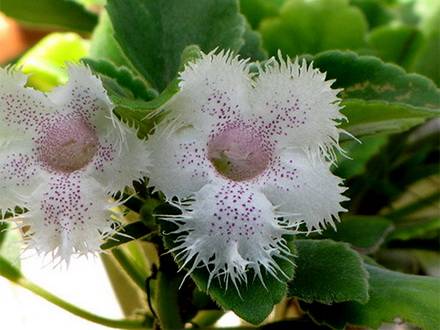

Alsobia punctata - Alsobia punctata... Herbaceous perennial with a sturdier, often erect, stiff stem. It grows more slowly than others, forming an erect bush with a stiff stem, long internodes and hanging stolons. Rosettes are formed at a great distance. The mustache is flexible and dangles freely. The diameter of the rosettes is 8-10 cm.
Oval-pointed flat leaves of dark green color with small serrations along the edge and with a slight pubescence of white. The flowers are quite large, with a cream or light green hue and numerous blotches of red or pink in the neck of the flower, with fringed edges. They are located on short pedicels in the leaf axils.
Hybrid varieties:
In indoor floriculture, the appearance of new hybrids is not uncommon. Their flowers are usually larger.
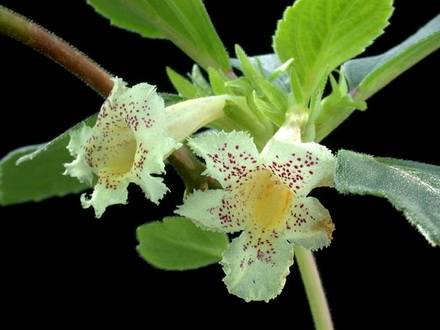

Alcobia Chiapas... (Chiapas). This hybrid variety belongs to the shrub species, grows in the form of a bush. The leaves are rather large, ovoid, light green in color, with a sharp tip and a weak edge. It has large flowers with a cream shade (sometimes greenish-yellow), with velvety edges of the petals, the neck of the flower is strewn with purple blotches.
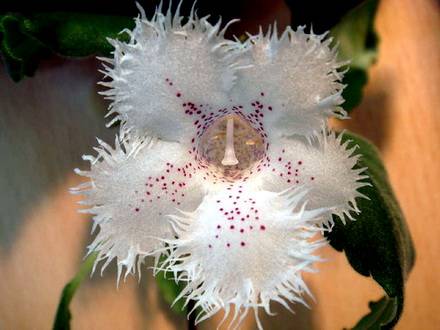

Alcobia Cygnet... (Young swan). This is a hybrid obtained by crossing two species of Alsobia - Alsobia punctata and Alcobia dianthiflora. The plant has rather large toothed leaves of a light green hue with slight pubescence. A rosette with a diameter of 8-10 cm. One of the most stable hybrids, it grows rather quickly. It has bright white flowers 3-4 cm in diameter, corrugated, decorated with small pink specks. The pharynx of the flower is strewn with numerous small blotches of red or pink color, which extend to the center of the petals.
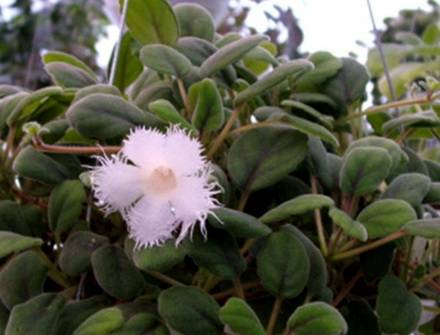

Alsobia Costa Rica... It has greenish-white flowers with curved petals and smaller, green leaves.
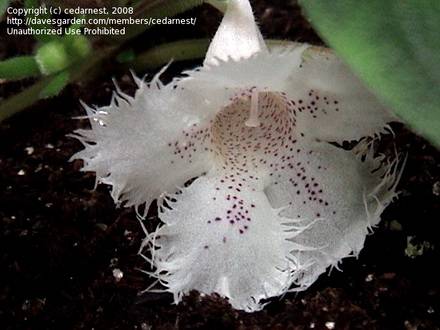

Alsobia Iris August... It has white flowers with purple spots on the throat. Gray-green leaves.
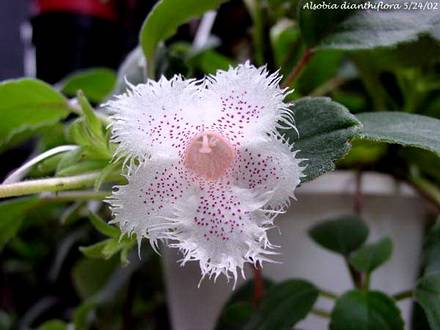

Alsobia San Migel... The flowers and leaves are larger than those of other varieties. It is larger but slower growing, characterized by early flowering. Slightly pubescent toothed leaves have a light blue-green tint. The plant blooms with white flowers with a creamy shade and dotted blotches of red or burgundy in the throat of the flower, the edges of the petals are fringed.
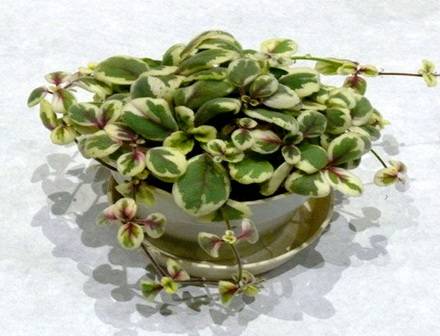

Alsobia Variegated... Has lemon or whitish streaks along the edge of the leaf. Sometimes stripes appear along the central vein of the leaves. The variegated color becomes brighter in good lighting and can fade from lack of light.
